Fourth and Glory! St. Joseph continues dynasty with victory over Tri-County in state title game
By DaviD W. Healy/Delta Dem ocrat times
JACKSON – It takes more than one player to make a dynasty.
These were the words from St. Jo seph Catholic School coach John Baker just minutes after his Fighting Irish de feated Tri-County Academy 26-14 to win the MAIS Class 4A State Champi onship Thursday at Jackson Academy. It was the Irish’s fourth state champi onship in school history and fourth in six years.
As they have done in their previous three state championships, the biggest stars on this year’s St. Joseph (11-1) team shined the brightest. But it was not just one star. The night and the glory belonged to the entire St. Joseph team who avenged a loss last season to Tri-County in last year’s state semifinal game.
Senior running back Kye Nelson, who played as a 5-foot-9 wrecking ball the entire game, carried the ball for crucial yardage time after time again. In the second half, Nelson’s determi nation came to a crescendo when his 34-yard touchdown score put the Irish in the lead for good at 20-14 with 1:56 to play in the third quarter. Nelson finished the night with 144 yards rushing on 16 carries.
“I was just thinking after every carry to keep going and keep fighting,” Nelson said. “This game was revenge for us because Tri-County beat us in the semifinals last season.”
Said Baker, “Kye and the offensive line, they put the whole team on their backs and they got us in the endzone. We made the decision to run the ball in the second half because we felt like we were more physical team and at half time we thought if we ran the ball we could win.”
Nelson missed last year’s state semi final with an injury.
Senior quarterback CJ Moore was another Irish player who helped ce ment the Irish dynasty Thursday night.

Moore is the brother of the first two Irish quarterbacks, Brice Johnson and Dillon Johnson, who helped lead the Irish to their first three state champion ships in 2017, 2018 and 2019. During Thursday’s contest, Moore looked much like his older two brothers when they were leading the Irish to state glo ry. As he had all season, Moore extend ed offensive plays with his speed and escapability.
After Tri-County opened the scor ing when QB Bryce Warriner connect ed with Ty Milner on a 13-yard touch down pass with 2:59 left in the first quarter, Moore found a wide-open Christian Foster in the back of the endzone for 24-yard touchdown reception to give St. Joseph a 7-6 lead.
Later in the second quarter, Moore made his biggest play of the game when he raced down the right sideline for a 76-yard touchdown run to put the Irish up 14-6
Continued on page 6 –
'Fraternal dialogue,' more prayer have place on bishops' assembly agenda
By catHolic NeWs service
BALTIMORE – Gathered in Baltimore for their fall general assembly Nov. 14-17, the bishops elected new leadership, heard about the crisis in Ukraine and what's facing migrants at the U.S. southern border.


They also approved several liturgical items and OK'd the advancement of the sainthood causes of three Cath olic women.
The prelates also discussed whether they should update "Forming Consciences for Faithful Citizenship," their document on the political responsibility of Catho lics that they issue every four years for the presidential election.
By an overwhelming majority, the bishops voted to reissue the teaching document without revisions but to add supplemental materials and begin a process of re examining the teaching document following the 2024 election.
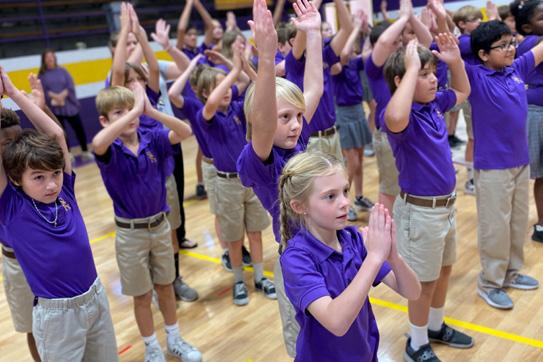
Speaking from the floor, several bishops said it must include what Pope Francis has said on critical issues of the day in his nearly 10 years as the successor to Peter.
But beyond the business agenda the bishops must
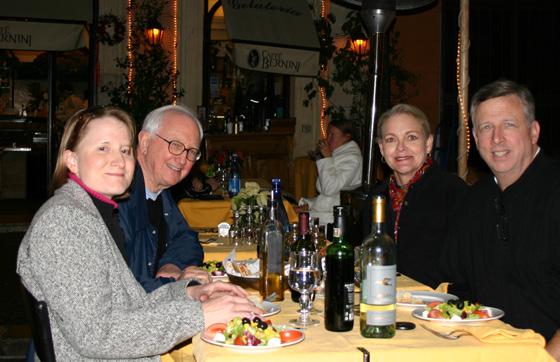
attend to every year, there was a greater emphasis on prayer throughout their four days together and changes in seating arrangements to promote "fraternal dialogue."
In the ballroom of the hotel where the assembly takes place, round tables replaced long rows of tables and chairs focused on the stage where USCCB leaders led proceedings.
Each day of the meeting ended with vespers and throughout the plenary, there also was 24-hour eucha ristic adoration, which was instituted at their 2021 as sembly. There were also less formal bishop-media en counters.
Their first public session took place the afternoon of Nov. 15 and opened with an address by Archbish
Continued on page 6 –
NOVEMBER 23, 2022 mississippicatholic.com
INSIDE THIS WEEK
Black Catholic Conf. 8 Blessing of Black Catholic Men's Conference
From the archives 10 Woodward gives thanks for gatherings around the table
Youth 15 Pictures of youth activities around the diocese
–
JACKSON – The Fighting Irish of St. Joe Greenville toppled Tri-County Academy for the MAIS Class 4A State Championship on Thursday, Nov. 17 at Jackson Acad emy. More photos at mississippicatholic.com. (Photos by Joanna Puddister King)
–
SPIRITUAL ENRICHMENT
FLOWOOD St. Paul, Women’s Ministry Advent Day of Reflection, Saturday, Dec. 3 from 9 a.m. to 2 p.m. Deacon Tony Schmidt will lead the day of reflection to help us in our spiritual journey during Advent. Cost: $10 donation to cover cost of lunch. Details: register at https://bit.ly/StPaulAdventReflection2022.
HERNANDO Holy Spirit, Advent/Christmas Con cert, Sunday, Dec. 4 at 4 p.m. The concert will be fol lowed by a parish dinner. Details: church office (662) 429-7851.
NATCHEZ St. Mary Basilica, Season one of “The Chosen” will be shown as an Advent/Christmas study on Mondays beginning Nov. 28, in the Family Life Cen ter at 6 p.m. The study will continue into the Mondays of January 2023. Each episode will include the use of Catholic study and discussion materials developed by the Augustine Institute and FORMED. Details: church office (601) 445-5616.
PARISH, FAMILY & SCHOOL EVENTS
ABERDEEN St Francis of Assisi, Christmas party af ter the 4 p.m. Mass on Saturday, Dec. 3. There will be a sign-up sheet posted on the bulletin board in the parish hall for you to sign up for what you would like to bring. We will play “Dirty Santa” following supper. Each person wanting to play needs to bring a $10 gift. Details: church office (662) 813-2295.
COLUMBUS Annunciation, Blood Drive, Monday, Nov. 28. Services Bus will be parked in our parking lot to accept any and all types of blood. Details: church office (662) 328-2927.
JACKSON St. Peter Cathedral, The Vigil Project will provide an evening of music/prayer/inspiration on Fri day, Dec. 9. The Vigil Project is a group of musicians and speakers from South Louisiana who host what they call

“True Presence Nights” at parishes around the country. The evening consists of adoration of the Blessed Sacra ment, music and inspirational talks from members of the group. Details: church office (601) 969-3125.
St. Richard, Christmas Candlelight Memorial Service, Thursday, Dec. 8, 6 p.m. at Foley Hall. Details: to RSVP, please contact Nancy McGhee (601) 942-2078 or nc mcghee@bellsouth.net.
MADISON St. Francis, Ring In Your Faith 10k run and 5k run/walk, Saturday, Dec. 31 at 8 a.m. Registra tion fee guarantees your shirt through Dec. 17 and you will enjoy a mouth-watering New Year’s Day meal with a Southern twist. Ring in 2023 and register here: https:// bit.ly/RingInYourFaith2022 Details: Joe at leslieslee@ hotmail.com.
St. Francis, Evening of Worship & Adoration for Ad vent and Christmas with music by John Finch, on Sun day, Dec. 4, 6:30-8 p.m. in the church. The evening will include a time of worship music, Advent reflection and Exposition of the Blessed Sacrament with Benediction. Open to the public, donations accepted. For more info on John Finish visit johnfinchmusic.com. Details: email mc.george@stfrancismadison.org.
MADISON St. Joseph School, Christmas Arts and Crafts Camp, Saturday, Dec. 17, St. Joe Fine Arts Build ing from 9 a.m. to 12 p.m. or 1-4 p.m. For grades K through eighth. Cost is $40 per session or $70 for both. Snacks included. Bring lunch if staying for both sessions. Details: email vrunnels@stjoebruins.com.
MERIDIAN St. Patrick, Candy Cane 5k Dash, Saturday, Dec. 3 at 8:30 a.m. Details: to register visit https://bit.ly/CandyCane2022.
NATCHEZ St. Mary Basilica, Advent Fair, Sun day, Dec. 11 at 2 p.m., Family Life Center, all PreK-4 through fifth graders are invited! Advent and Christ mas symbols and their history and meaning will be featured, with stories, crafts and treats. Details:
church office (601) 445-5616.
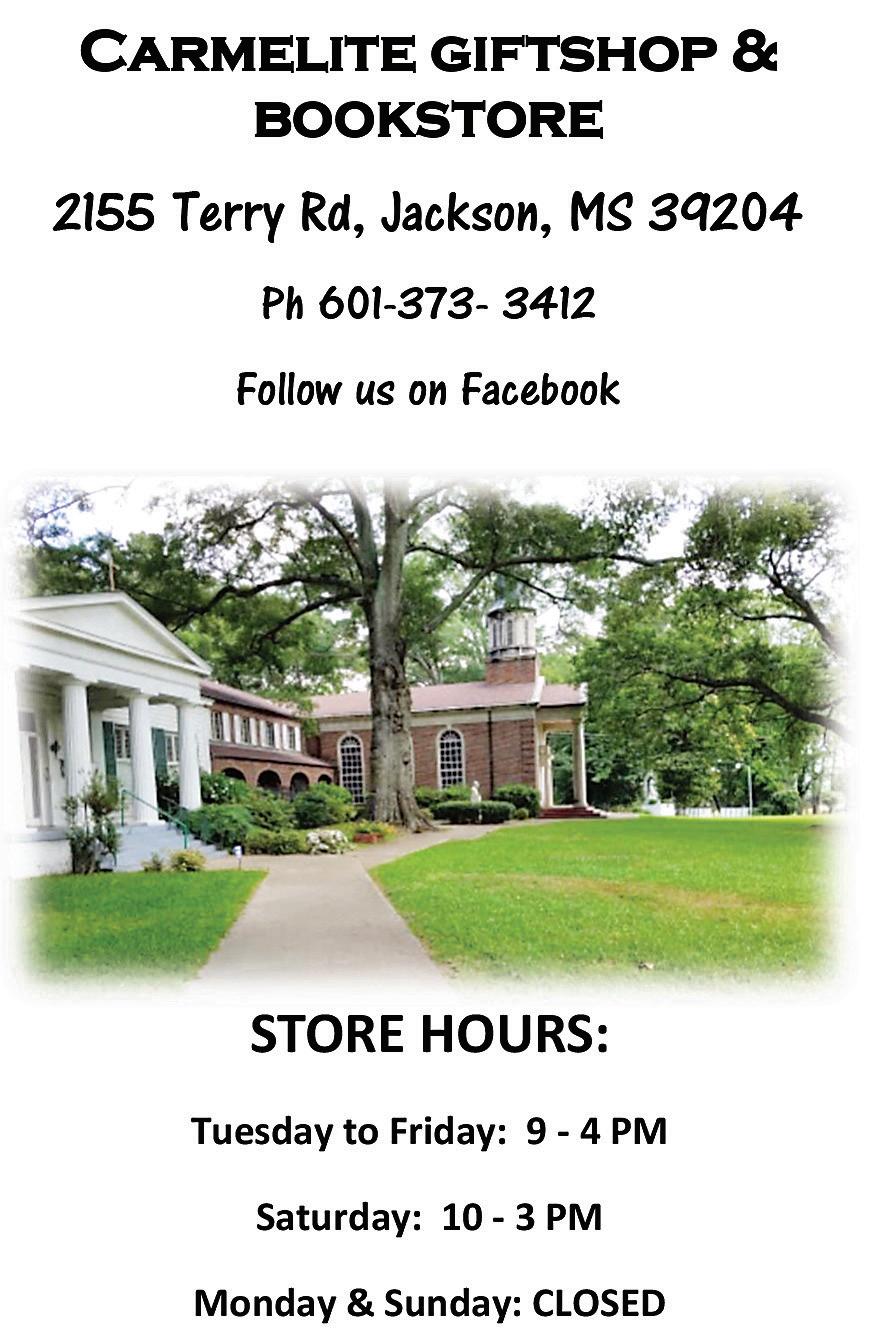
SAVE THE DATE
DIOCESE SEARCH Retreat – For Teens, By Teens, Jan. 13-15, 2023 at Camp Wesley Pines in Gallman. De tails: email abbey.schuhmann@jacksondiocese.org.
World Marriage Day, Feb. 12, 2023 at Jackson, St. Peter Cathedral. Details: register to attend with your home parish.
#iGiveCatholic on Giving Tuesday Nov. 28. Join Catholics in this nation-wide day of giving. Visit https:// jackson.igivecatholic.org to donate today!
JACKSON St. Richard School, Krewe de Cardinal set for Feb. 10. Call for tickets and sponsorship opportuni ties. Details: school office (601) 366-1157.
MADISON St. Anthony School, Starry Night Gala, Friday, Dec. 9. Details: school office (601) 607-7054.
BILOXI Our Lady of the Gulf Catholic Church, The Role of Beauty in the Spiritual Life: understanding and praying with the Church’s Sacred Music, Jan. 26, 2023 at 7 p.m. Event is a talk by Dr. Jennifer Donelson-Nowic ka. Details: visit olgchurch.net.
Our Lady of the Gulf, Sacred Music Workshop for cantors, choir members, music directors and clergy, Jan. 27-28, 2023. Cost is $40 with registration deadline of Jan. 13. Details: Registration and more information at classicalartsfoundation.com. Email workshop@classica lartsfoundation.com with questions.
23, 2022 MISSISSIPPI CATHOLIC
NOVEMBER
R dgeland Cl nton
APPLIANCE AUDIO VIDEO BEDDING FURNITURE SUPERSTORE
V cksburg Tupelo Columbus Laur el r Oxford Hat t esburg
Jackson Flowood Pearl
HALES CORNERS, Wis. – Three seminarians participated in the Rite of Admission to Candidacy for Holy Orders during Mass at Sacred Heart Seminary and School of Theology in Hales Corners on Nov. 9, 2022. This rite is an important step during a seminarian’s formation journey. Called forward by President-Rector Father Raúl-Gómez-Ruiz, each seminarian publicly declared his in tention to advance towards ordination, offering himself to God and a life of ministry. The three seminarians (from left to right) are Esteban Hernández from the Diocese of Dodge City, John Le from the Diocese of Jackson and Diego Osvaldo Acosta Chávez from the Diocese of Lexington. All three are seminarians at Sacred Heart. (Photo by Monica Misey)
FEATURED PHOTO
...S eminarian John Le continues formation
Bishop’s charter marks 20 years, church desires hope and healing
By Bishop Joseph R. Kopacz, D.D.
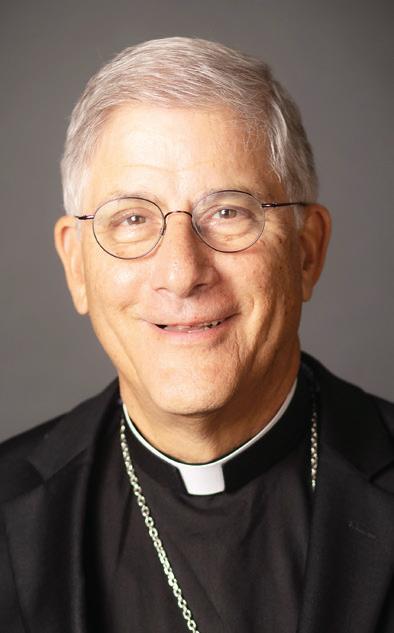

This year in the Catholic Church marks the 20th anniversary of the Dallas Charter, when the American Catholic Bishops through the charter document and its essential norms “promised to protect and pledged to heal,” committing the church to safe environments for our children, young people and their families.

Because of our sins and crimes, justly, as an organiza tion, the church has been in the crucible, and the purification continues. Yet, the experience of the past twenty years has shown that an organization’s culture can be transformed when best practices are put in place and all in the organization are required to abide by them. In the church, this includes all the ordained, professed and baptized who work with children.
Over the past twenty years new allegations and actual proven cases of abuse are far and few between. Even one case is one too many, but we have learned how to protect in our church programs and gatherings. Moreover, the pledge to heal comes from the heart of Jesus Christ because we are his body, far more than an organization, who hunger and thirst for healing and peace for all who have been so unjustly harmed by wolves in sheep’s clothing. This Gospel imperative must be at the center of all that the church does on the road back to the abundant life Jesus promised to all believers.
For all in the church and in the world who are stead fast in their love for children’s safety and flourishing, we can rejoice in the recent declaration of the United Nations.
On Nov. 10, 2022, the General Assembly declared Nov. 18 as the World Day for the Prevention of, and Healing from Child Sexual Exploitation, Abuse and Vi olence. The resolution, which was sponsored by Sier ra Leone and Nigeria and co-sponsored by more than 120 countries, was adopted by consensus and a bang of the gavel by the assembly’s acting president, which was greeted with loud applause. Following the action, H.E., Archbishop Gabriele Giordano Caccia, Permanent Observer of the Holy See United Nations, New York ad dressed the Assembly expressing appreciation for the UN’s action, and the full support of the Vatican State for the newly adopted World Day.
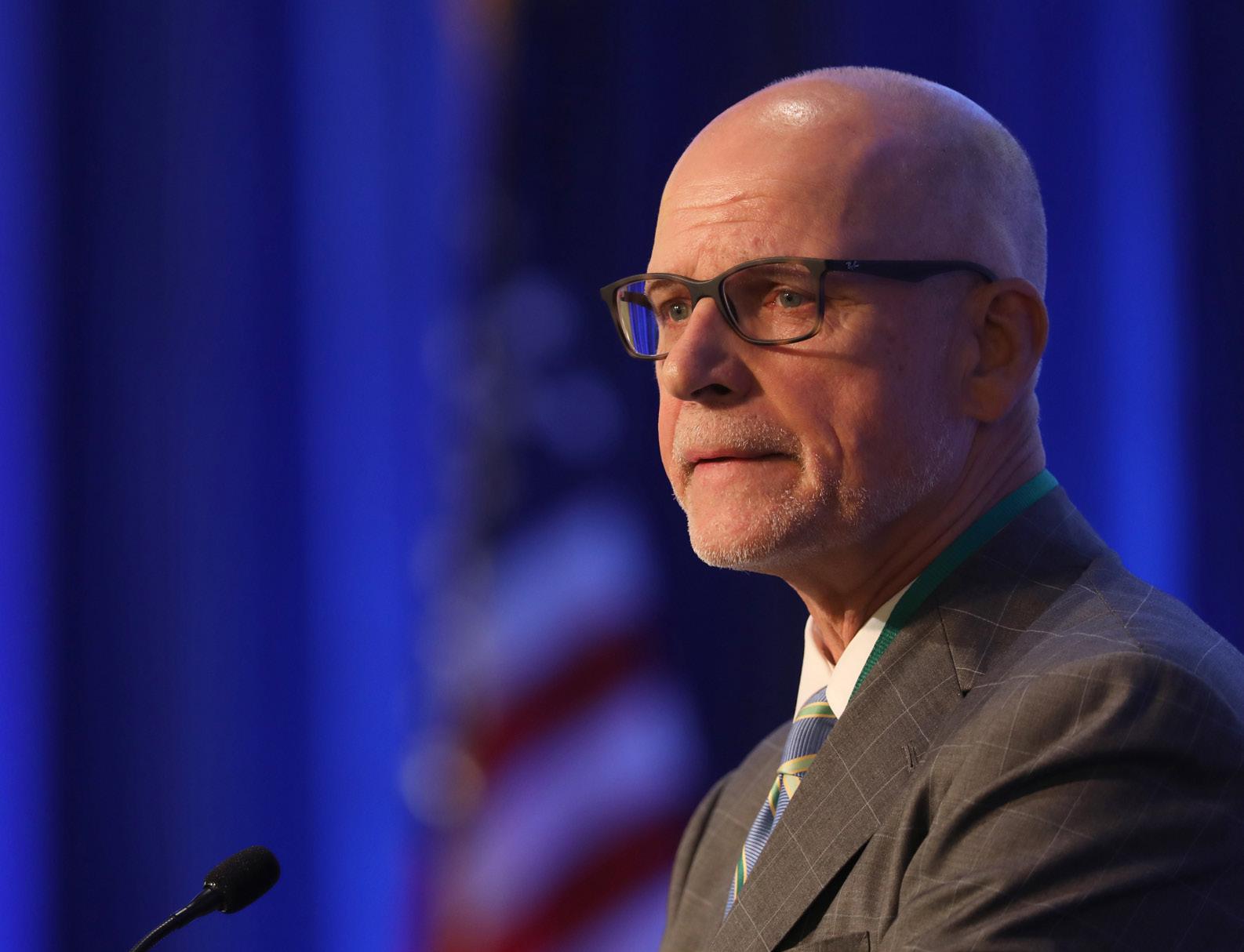
Over 50 individu als including leaders of prominent child welfare and advoca cy organizations, and survivors of child sexual abuse (CSA), including several who experienced abuse by clergy, joined H.E. Fatima Maada Bio, the First Lady of the Republic of Sierra Leone, a survivor of child marriage, as she addressed the Gener al Assembly urging action. “Child sexual abuse is a global pub lic health crisis. We must acknowledge this problem, and take every necessary action to protect our children, especially our girls, from this tragic human condi tion.” Her eloquent, impassioned speech was greeted with a round of applause, and cheers from survivors in the gallery.
Mark Joseph Williams, an abuse survivor, speaks during a Nov. 15, 2022, session of the fall general assembly of the U.S. Conference of Catholic Bishops in Balti more. (CNS photo/Bob Roller)
“Child sexual abuse is one of the greatest violations to human dignity, one can suffer,” said H.E. Ambassador Alhaji Fanday Turay. “The World Day for the Prevention of, and Healing from Child Sexual Exploitation, Abuse and Violence is a critical step in bringing institutional recognition to this horrific childhood trauma. Too many victims of child sexual abuse are suffering in shame and silence. Many live anguished lives. By adopting this Res olution, we can provide a platform for all nations and civil society to mobilize and take actions to protect chil dren from this tragedy.”
“We promoted the World Day to increase aware ness of the actions all governments can take to prevent abuse and bring healing to survivors,” said Dr. Jenni fer Wortham, a researcher at Harvard who founded the Global Collaborative, the survivor led network that led the international advocacy campaign to launch the world day. Wortham’s brothers are clergy abuse survivors, and Wortham shared that they
have struggled with the effects of their abuse for their entire lives. “The World Day will help my brothers and all survivors of child sexual violence to know that the world cares about them, that they matter, that what they experienced was unjust, and that healing is possible,” said Wortham.
Finally, the world has spoken, and this is a victory for us all,” said Mark Williams, clergy abuse survivor, and advisor to the Archdiocese of Newark. “This day has been extraordinary, I am filled with awe, and peace.” At the Bishop’s recent meeting in Baltimore, Williams ad dressed the assembled body along with Cardinal Joseph Tobin, his Archbishop of Newark, N.J. to encourage the bishops that the Lord can make a way where there is no way. Healing, hope, and a new dawn are God’s desire for all in the church, especially the victims of sexual abuse.
Williams and Cardinal Tobin’s witness and friendship from the center of the church, the United Nations decla ration, and a growing world-wide commitment to human flourishing on behalf of children and young people make this Thanksgiving an extra special day of gratitude in our nation and in our world.
BISHOP’S SCHEDULE
Tuesday, Nov. 29, 10:30 a.m. – Blessing of “Touchdown Jesus” statue, St. Joseph High School football field, Greenville
Sunday, Dec. 4, 11 a.m. – Confirmation, Immaculate Heart of Mary, Greenwood
Sunday, Dec. 11, 11:45 a.m. – Procession of Our Lady of Guadalupe, Cathedral of St. Peter the Apostle, Jackson
Monday, Dec. 12, 7 p.m. – Mass for Our Lady of Guadalupe, Cathe dral of St. Peter the Apostle, Jackson
MISSISSIPPI CATHOLIC
an
publication of the Diocese of Jackson, 601-969-1880, 237 E. Amite St., Jackson, MS 39201. Published digitally twice per month January - April and September - December; once per month June, July and August. Subscription rate: $20 a year in Mississippi, $21 out-of-state. Mississippi Catholic mails 14 editions per year – twice per month in December and January; and once per month February – November. For address changes, corrections or to join the email list for the digital edition, email: editor@jacksondiocese.org.
Website: www.mississippicatholic.com w www.jacksondiocese.org
Sunday, Dec. 18, 11 a.m. – Mass and Christmas Dinner, St. Patrick, Meridian
All events are subject to change. Check with parishes and schools for further details.
CATHOLIC NOVEMBER 23, 2022 let there be light Publisher Bishop
R. Kopacz Communications Director Joanna Puddister King Production Manager Tereza Ma Contributors ......................................................................................................... Berta Mexidor P.O. Box
E-mail:
Volume 68 Number 21 (ISSN
MISSISSIPPI
Joseph
2130 Jackson, MS 39225-2130 Phone: 601-969-3581
editor@jacksondiocese.org
1529-1693)
is
official
The Friday before Thanksgiving is a day of great rejoicing for many of our seminarians. For one thing, their Thanksgiv ing break has arrived and they’ll have a week to spend with family and friends and prepare for their final exams. That Friday is also the day of the annual bonfire at St. Joseph Seminary College.
This tradition that goes back many decades and so many of our priests have taken part in it (including myself). The students at St. Joseph (which, because it is a Benedictine monastery, we know as St. Ben’s – confusing I know!) spend the early weeks of November gathering and stacking timber that has fallen around the property and then stuffing it with as much brush as they can. Thankfully there are 1200 acres of trees at St. Ben’s and usually a hurricane will have pushed through earlier in the fall and provided plenty of raw material. The night before the bonfire the students and faculty have a gathering to bless the fire and ask the Lord to make the next evening a time of fraternity and community that will build up the future priests of the church. Then on bonfire day the men from Notre Dame in New Orleans cross Lake Pontchartrain to join their younger brethren for a football game followed by a great dinner and the lighting of the fire.
My favorite bonfire memories were usually from the football game. It’s amazing how pumped up you can get to compete against another team when there is only one other team to compete against and you only play them once a year. I used to always play receiver, not because I was athletic, but because I was a good field spacer because I knew all the routes and I could open up the field for our more athletic teammates to get open. One time, our quarterback threw me a bone and tossed me a touchdown pass on 4th and goal from the 1-yard line. I was so honored that he trusted me in that moment, but when we talked about it on the sideline, he said — “that was 4th down? I thought it was 3rd or I would have never thrown that to you!”
Those moments are particularly fun for me to reflect on now that I am walking with our current seminarians. Their great memories will be differ ent from mine, but I know that the Lord will give them the same encouragement from these events that I received. The fraternity experienced in seminary is special, and it has endured long after ordination. We have so much great support for our seminarians throughout the diocese, and that support doesn’t just help them learn about theology and liturgy, it gives them opportunities to build friendships that will help sustain their ministry for decades to come.
Father Nick Adam

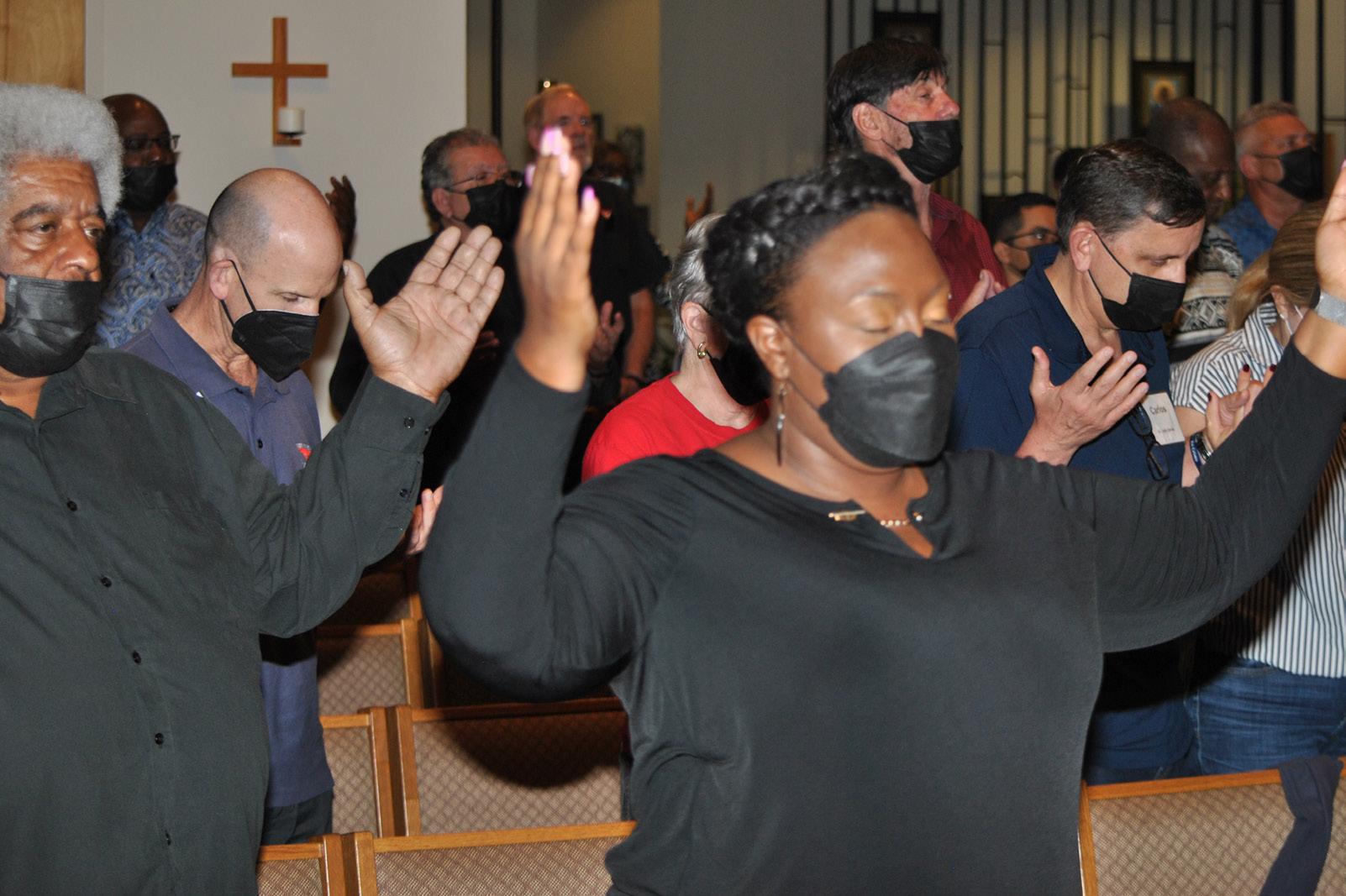

If you are interested in learning more about religious orders or vocations to the priesthood and religious life, email nick.adam@jacksondiocese.org.
Mission partners pilgrimage
Bishop Joseph Kopacz joined the pilgrimage, presiding and preaching at the closing liturgy for the group on Oct. 23 at Sacred Heart Mission in Camden. The Mass was followed by a reception and meal. It was an evening of thanksgiving to the Lord for the collaborative spirit of the diocese, Missionary Servants and lay missionaries.
The pilgrimage was followed by a week of mission volunteers repairing homes and trailers in the Camden and Carthage communities.
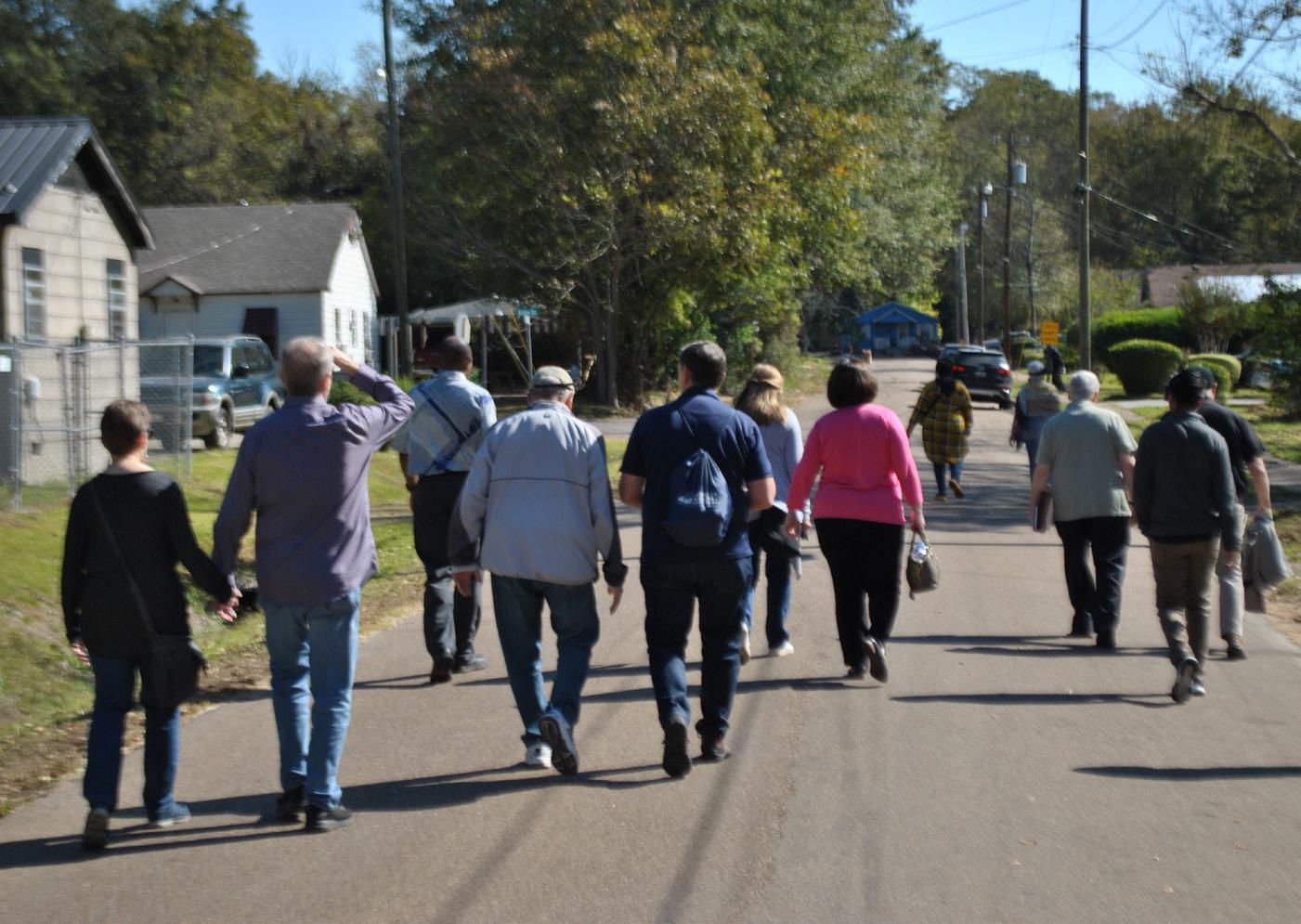
NOVEMBER 23, 2022 MISSISSIPPI CATHOLIC 4 VOCATIONS
CALLED BY NAME
Father Nick Adam
Twenty-five mission partners made a spiritual pilgrimage to the churches and mis sions of the Missionary Servants of the Most Holy Trinity in the Diocese of Jackson from Oct. 20-23. Mission partners are lay and religious faithful who serve as advi sors and prayer partners of the Missionary Servants who respond to specific needs and encourage mission outreach on a daily basis. The partners visited and met with the faithful at Holy Child Jesus in Canton where they visited the family home of Sister Thea Bowman, Holy Rosary Native American Mission in Tucker, St. Anne Church in Carthage and Sacred Heart Mission in Camden.
(Photos by Father Guy Wilson, ST)
Can anything good come from Okarche Oklahoma?
IN EXILE
By Father ron rolheiser, oMi
It is not enough merely to have saints; we need saints for our times! An insightful comment from Simone Weil. The saints of old have much to offer; but we look at their goodness, faith, and selflessness and find it easier to admire them than to imitate them. Their lives and their circumstances seem so removed from our own that we easily distance ourselves from them.
So, I would like to propose a saint for our times, Stanley Rother (1935-1981), an Oklahoma farm boy who became a missionary with the poor in Atitlan, Guatemala, and eventually died a martyr. His life and his struggles (save perhaps for his extraordinary courage at the end) are something to which we can easily relate.
Who is Stanley Rother? He was a priest from Oklaho ma who was shot to death in Guatemala in 1981. He has been beatified as a martyr and is soon to become the first male born in the United States to be canon ized. Here, in brief, is his story.
Stanley Rother was born to a farming family in Okarche, Oklahoma, the oldest of four children. He grew up helping work the family farm and for the rest of his life and ministry he remained forever the farmer more than the scholar. Growing up and working with his family, he was more at home tilling the soil, fixing engines and digging wells than he was reading Aristo tle and Thomas Aquinas. This would serve him well in his work with the poor as a missionary, though it served him less well when he first set out to study for the priesthood.
His initial years in the seminary were a struggle. Trying to study philosophy (in Latin) as a preparation for his theological studies proved a bit too much for him. After a couple of years, the seminary staff advised him to leave, telling him that he lacked the academic abilities to study for the priesthood. Returning to the farm, he sought the advice of his bishop and was even tually sent to Mount St. Mary’s Seminary in Maryland. While he didn’t exactly thrive there academically, he thrived there in other ways, ways that impressed the seminary staff enough that they recommended him for ordination.
Back in his own diocese, he spent the first years of his priesthood mostly doing manual work, redoing an abandoned property that the diocese had inherited and turning it into a functioning renewal center. Then, in 1978, he was invited to join a diocesan mission team that had begun a mission in Guatemala. Every thing in his background and personality now served to make him ideal for this type of work and, ironically, he, who once struggled to learn Latin, was now able to learn the difficult language of the people he worked with (Tz’utujil) and become one of the people who helped develop its written alphabet, vocabulary and grammar. He minis tered to the people sacramentally, but he also reached out to them personally, helping them farm, finding resources to help them and occasionally giving
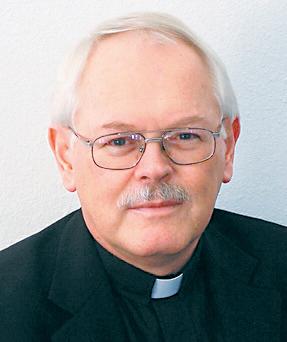
them money out of his own pocket. Eventually he be came their trusted friend and leader.
However, not everything was that idyllic. The polit ical situation in the country was radically deteriorating, violence was everywhere and anyone perceived to be in opposition to the government faced the possibility of intimidation, disappearance, torture and death. Stanley tried to remain apolitical, but simply working with the poor was seen as being political. As well, at a point, a number of his own catechists were tortured and killed and, not surprisingly, he found himself on a death list and was hustled out of the country for his own safety. For three months, back with his family in Oklahoma, he agonized about whether to return to Guatemala, know ing that it meant almost certain death. The decision was especially difficult because, while clearly he felt called to return to Guatemala, he worried about what his death there would mean to his elderly parents.
He made the decision to return to Guatemala, fired by Jesus’ saying that the shepherd doesn’t run when the sheep are in danger. Four months later, he was shot to death in
the missionary compound within which he lived, fighting to the end with his attackers not to be taken alive and made “to disappear.” Instantly, he was recognized as a martyr and when his body was flown back to Oklahoma for burial, the community in Atitlan kept his heart and turned the room in which he was martyred into a chapel.
A number of books have been written about him and I highly recommend two of them. For a substantial bi ographical account, read Maria Ruiz Scaperlanda, The Shepherd Who Didn’t Run. For a hagiographical tribute to him read Henri Nouwen, Love in a Fearful Land.
We have patron saints for every cause and occa sion. For whom or for what might Stanley Rother be considered a patron saint? For all of us ordinary people of whom circumstance at times asks for an exceptional courage.
(Oblate Father Ron Rolheiser is a theologian, teacher and award-winning author. He can be contacted through his website www.ronrolheiser.com.)
Pope’s Corner Live the Gospel by treating others as a brother or sister, pope says
By Cindy Wooden
VATICAN CITY (CNS) – Treating everyone as a brother or sister is the clearest, most simple way to live the Gospel each day, Pope Francis said.
“It is an invitation without exclusion: brothers and sisters all in humanity and love,” the pope wrote in a message to members of FOCSIV, a federation of most ly Italy-based Catholic volunteer organizations that work internationally.
Representatives of the federation met the pope at the Vatican Nov. 14 as part of their celebration of the organization’s 50th anniversary. Twenty organizations founded the group in 1972; today it includes 94 orga nizations working in 80 countries.
Ivana Borsotto, the group’s president, told Pope Francis, “We seek to be a neighbor in the most aban doned peripheries, in the most remote villages, in the most inhumane prisons, along the cruelest migratory routes, in the most crowded refugee camps and in wartorn countries.”
In his prepared text, Pope Francis said development work, like what FOCSIV members promote in many of the world’s poorest countries, is the only real response to concerns about migration.
“Think of how many young people today are forced to leave their land in search of a dignified existence; how many men, women and children face inhumane journeys and violence of all kinds in order to seek a better tomorrow; how many continue to die on the routes of despair, while their fate is discussed or we turn away,” the pope wrote.
“Forced migration – to escape war, hunger, persecu tion or climate change – is one of the great evils of this age,” he wrote, and “we will only be able to address at its root by ensuring real development in every country.”
At the audience, Pope Francis asked Borsotto to deliver his prepared text to the members, but said he wanted to speak more about what was in his heart.
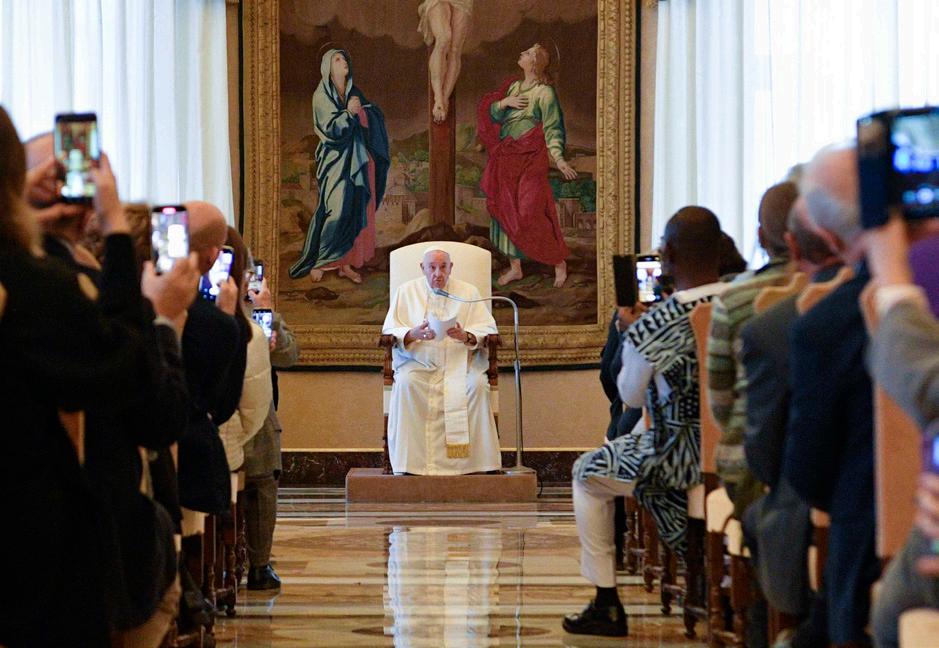
Volunteering is a characteristic of Italians and some thing not as common elsewhere, he told them. “It is one of the most beautiful things” because it involves making a free choice to go out and personally help someone in need.
“One has to take action. I can stay at home sitting quietly, watching TV or doing other things – no, I make this effort to go out,” he said. “Volunteering involves effort to go out to help others, that’s how it is. There is no desk volunteering and there is no television vol unteering, no. Volunteering is always going out with an open heart, an outstretched hand, the legs ready to go.”
But it also involves meeting someone, listening to them and sharing with them, he said.
“We are living in a civilization of confrontation,” he said, and wars are just one sign of it.
“One clash after another and we never learn – not on a world level and not on a personal level,” Pope Francis said.
People even seem to define themselves by their op position to someone or some idea, he said. It’s like they say, “’I don’t know who I am, but I am against this and against that.’ Their identity is being-against, clashing.”
But, he said, volunteering is “an ode to fraternity” and to recognizing that no matter the differences of culture or opinion, all people are brothers and sisters.
After setting aside his prepared text, Pope Fran cis speaks about the beauty of volunteering to members of FOCSIV, a federation of mostly It aly-based Catholic volunteer organizations that work internationally, during an audience in the Consistory Hall of the Apostolic Palace at the Vatican Nov. 14, 2022. (CNS photo/Vatican Media)
MISSISSIPPI CATHOLIC NOVEMBER 23, 2022 5 Spirituality
Passbach Meats Inc. Wholesale and home freezer service Beef – Pork – Sausage 109 - A Camellia Dr. Natchez 601-445-8743
The
'... incredible momentum ...'
op Christophe Pierre, the papal nuncio, followed by Archbishop José H. Gomez of Los Angeles, the outgoing president of the U.S. Conference of Catholic Bishops.
The nuncio told the bishops that "as we live through a time of accelerated change," spreading the Gospel message is particularly important.
One way to determine if the church is following its missionary role is to look at how local churches are functioning as evangelizing communities, something he said is especially evident in the current eucharistic revival in the United States.
In his final presidential address, Archbishop Gomez described images of conflict, changes and challenges he saw during his three-year term.
He spoke of the pandemic, "a long season of unrest in our cities," a contentious presidential election as well as "deepening political, economic and cultural divisions," war in Europe, a refugee crisis and "the overturning of Roe v. Wade."
He raised alarm over what he saw as a U.S. society moving "hard and fast toward an uncompromising secularism," adding that "traditional norms and values are being tested like never before."
In their elections, the bishops chose Archbishop Gomez's successor – Archbishop Timothy P. Broglio of the U.S. Archdiocese for the Military Services. He was elected from a slate of 10 nominees, winning with 138 votes.
In subsequent voting, Archbishop William E. Lori of Baltimore was elected USCCB vice president. He won the post on the third ballot by 143-96 in a runoff with Bishop Kevin C. Rhoades of Fort Wayne-South Bend, Indiana.
The outgoing USCCB officers completed their three-year terms at the conclusion of the assembly, and their successors began their three-year terms.
Archbishop Broglio told reporters a few hours after he was elect ed that he is willing to meet with public officials, including President Joe Biden, to discuss public policy issues of concern to the church.
"I don't see my role as political, but if there is any way to insert the Gospel into all aspects of life in our country, I certainly will not miss any occasion to do that," he said, adding that Archbishop Go mez had desired to meet with Biden, but that such an opportunity did not present itself since Biden's election two years ago.
The afternoon public session ended with an acknowledgement of the 20th anniversary of the drafting and passage of the "Charter for the Protection of Children and Young People," with prayer and reflection led by Cardinal Joseph W. Tobin of Newark, New Jersey.
The prelates also heard poignant remarks from Mark Williams, a survivor of sexual abuse by a Catholic priest. He told the bishops he was "grateful and encouraged by the work you are doing to rid abuse from our beloved church."
Bishop James V. Johnston Jr. of Kansas City-St. Joseph, Missou ri, outgoing chairman of the Committee on the Protection of Chil dren and Young People, said the past 20 years have been a time of growth, awareness, examination and conversion as the church has worked to provide a safe environment and restore justice.
During their public sessions Nov. 15 and 16, the bishops heard several reports, including on:
– Preparations for the next October's world Synod of Bishops on synodality:
Work is proceeding – and quickly, according to Bishop Daniel E. Flores of Brownsville, Texas, chairman of the bishops' doctrine committee. Diocesan listening sessions concluded this fall. He said dioceses "managed to host over 30,000 listening sessions and other means of coming together." Now comes "the continental stage" of consultations.
– The ongoing war in Ukraine:
Archbishop Borys Gudziak of the Ukrainian Catholic Archepar chy of Philadelphia asked his fellow U.S. bishops Nov. 16 to pray for Ukraine, and, if possible, to go to Ukraine and pray there for its people. What Ukrainians are facing amounts to genocide, he said. He thanked the bishops and their leadership for spearheading U.S. Catholic support for a nation under attack by Russia since February.
– The three-year National Eucharistic Revival, which is now un der way at the diocesan level and will culminate in the National Eucharistic Congress in Indianapolis in 2024:
Bishop Andrew H. Cozzens of Crookston, Minnesota, chairman of the USCCB's Committee on Evangelization and Catechesis, which is spearheading the revival, said the revival has "incredible momen tum." The ultimate goal, he said, is that this "this encounter with Jesus in the Eucharist" will move Catholics who have been part of this experience to be missionary disciples who would in turn lead
others to the faith.
– The pro-life landscape after the Dobbs decision overturned Roe v. Wade:
Archbishop Lori, speaking as outgoing chairman of the USCCB's Committee on Pro-Life Activities, said that in a year when abortion has been front and center in U.S. politics – from the Supreme Court decision to recent state referendums – the Catholic Church faces a challenge of promoting its pro-life message to its own members and society at large.
"We have more work to do," he said, but stressed church leaders must must remain united in their efforts to "proclaim the Gospel of life and defend human life at every stage."
Among liturgical action items before them, the bishops approved English and Span ish versions of "Lay Ministry to the Sick," a collection of texts taken from other litur gical books. They also approved new Mass texts for the feasts of Our Lady of Loreto (Dec. 10) and the recently canonized St. Paul VI (May 29).
The approved texts now advance to the Vatican's Dicastery for Divine Worship and the Sacraments for a "recognitio" before they can be used in the United States.
The bishops also gave their assent in voice votes to the advancement of three sainthood causes:
– Mother Margaret Mary Healy Murphy, founder of the Sisters of the Holy Spirit and Mary Immaculate, the first order of women religious in the state of Texas.
– Cora Louise Evans, a California laywoman who was a wife, a mother and possible mystic.
– North Dakota laywoman Michelle Duppong.
(Contributing to this report were Carol Zimmermann, Rhina Guidos, Dennis Sadowski and Mark Pattison.)
'... St. Joe is a really good team ...'
– Continued from page 1 –
with 2:57 left in the second quarter. The Irish finished with 264 rushing yards.
“CJ pulls a rabbit out of his hat every time,” Coach Baker said. “He is the best athlete on our team. He doesn’t let things get to him. He threw an early pick, but he came back and reset and ran that long touchdown for us.”
Moore ended the game 14 of 29 with 163 yards passing. He had 114 yards rushing. St. Joseph’s Stank King led the Irish with 55 yards receiving on five catches. Chris Mayfield had 53 yards receiv ing for the Irish on three catches.
While the St. Joseph offensive players did their part for the victory, the Irish defense also stood tall when it mattered the most, holding the Rebels scoreless in the second half.
On Tri-County’s first offensive possession of the game, defensive end Donnie Smith recovered a Rebel fumble at the Tri-County 38-yard line. In the second quarter, defensive back Stank King made an interception and returned it 15 yards to the Irish 37-yard line.
In the third quarter, St. Joseph defensive lineman Alex Foster helped to end a Rebel drive with a 15-yard sack for a loss.
Later in the third, King deflected a Tri-County pass in the back of the endzone that looked at first like it was a sure touchdown.
The Rebels managed just 49 rushing yards in the game.
Tri-County head coach Phillip Wasson, a Greenville native who once coached at St. Joseph and Washington School, praised the Irish on their state championship.
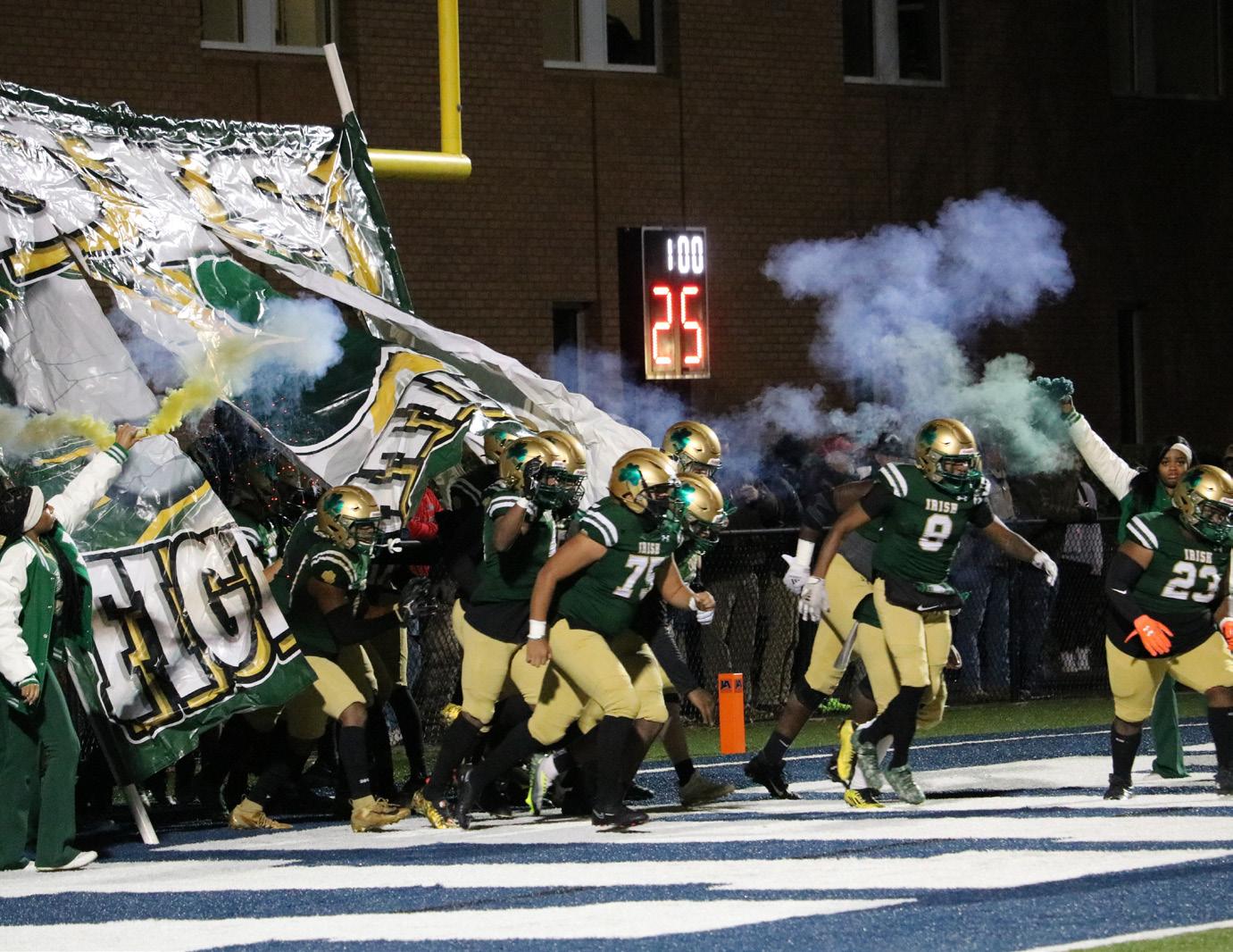
“St. Joe is a really good team,” Coach Wasson said. “Most of their best players are all back from last year. Coach Baker has done a good job with them. They have only lost one game this year. I am proud of that group be cause I know a lot of those kids over there at St. Joe.”
(David Healy is sports editor for the Delta Dem ocrat-Times. He can be reached at dhealy@ddtonline. com. Re-printed with permission.)
NOVEMBER 23, 2022 MISSISSIPPI CATHOLIC 6 DIOCESE
– Continued from page 1 –
Former evangelical ‘reboots’ message on movies for Catholic audience
By AllAn F. Wright CAtholiC neWs serviCe
”The Message Behind the Movie – Reboot: Engaging Film Without Disengaging Faith” by Douglas M. Beaumont. Ignatius Press (San Francisco, 2022). 243 pp., $17.95.
Douglas M. Beaumont is a former evangelical who joined the Catholic Church several years ago. A former professor in an evangelical Christian seminary, he has published a Catholic update and “reboot” of his 2009 book, “The Message Behind the Movie.”
In an age when Christians can access online web sites that reveal the number of times profanity is used in a film, how many sexual scenes and sexual references there are and how many drug references, Beaumont pro vides a biblical framework in which a religious believer can evaluate a film, absorb the positive elements and use various aspects of the film in communicating the Gospel.
His ability to provide a balanced, well-thought-out view on the Scriptures and a positive point of view on a Christianity’s ability to be “in the world” but not “of the world” is quite refreshing and encouraging.
The author loves movies and sees the value of the art form, the significance movies have in forming the values of our culture and the practical opportunities they bring to find common ground with others in order to bring the truth of the Gospel and conversations on faith.
The author makes it clear that increasing our plea sure in movie watching is not the primary goal, but rather to learn how to evaluate a movie in light of Christian be liefs. Analogous to great music or art that communicated an aspect of God’s sovereignty or Christ’s compassion for past generations, movies can do likewise.
This involves discerning the message of the movie revealed by its story, the structure and the assumed worl dview of that story. Beaumont would argue that “only then can Christians evaluate whether the movie presents a strong Christian, non-Christian or anti-Christian world view, which they can then respond to and use as a start ing point for apologetics and evangelism.”
This is the cover of the book “The Message Behind the Movie – Reboot: Engaging Film Without Disen gaging Faith” by Douglas M. Beaumont. The book is reviewed by Allan F. Wright. (CNS photo/courtesy Ignatius Press)

By discussing the cinematic techniques and the genre considerations filmmakers use to communicate their ideas, this book helps Catholics and other Christians to be come informed viewers. The book shows how to evaluate the stories that movies tell and how to discern what they say about reality, God and what it means to be human.
At the same time, he illustrates how movie watch ers can engage in thoughtful, lively discussions not only about film but also about the big questions in life.
The book is organized in three basic “acts.” Act One focuses on watching and understanding movies. Act Two discusses the evaluation process. Act Three explores what kinds of movies to watch and what kinds of movies to avoid. Ultimately, the author seeks to “show how we can all better interact with our culture by understanding the movies that shape and reveal it.”
The author begins by setting forth the historical con text by which we knowingly or unknowingly evaluate entertainment. The two positions find their origins in Plato and Aristotle. Plato held that art is basically useless and may even be harmful.
Beaumont sides with Aristotle and writes approving ly: “An Aristotelian approach to movies needn’t condone sinfulness; instead, it can recognize how central story telling is to human experience and seek to accurately critique the messages that stories in films are communi cating.”
In Act Two, on evaluating and discussing movies, Beaumont encourages Christians to discern good and bad in movies. He prompts Christians to use movies as a starting point in sharing the Gospel message and to discern the philosophical angle that may “open doors to conversations which may clarify the faith.” In Jesus’ para bles, the listeners are obliged to do the same.
In Act Three, on applauding and avoiding movies, the author not only has his eye on culture; he also rejects the sympathetic attitude that some Christians have to ward postmodernity and positions himself in a school of thought that is focused on classical apologetics.
The book has excellent insights into the production of a movie and ends with a commentary on the film, “The Truman Show.” Parents should certainly have dis cretion over what is allowed in their households and the rating designation of a movie can be informative for age-appropriate viewing.
The reader will gain appreciation for the messages that are found within movies, which can be a starting point for dialogue with people of divergent faith backgrounds or no faith at all.
St. Andrew the Protokletos – the first called
STEWARDSHIP PATHS
By JuliA WilliAms
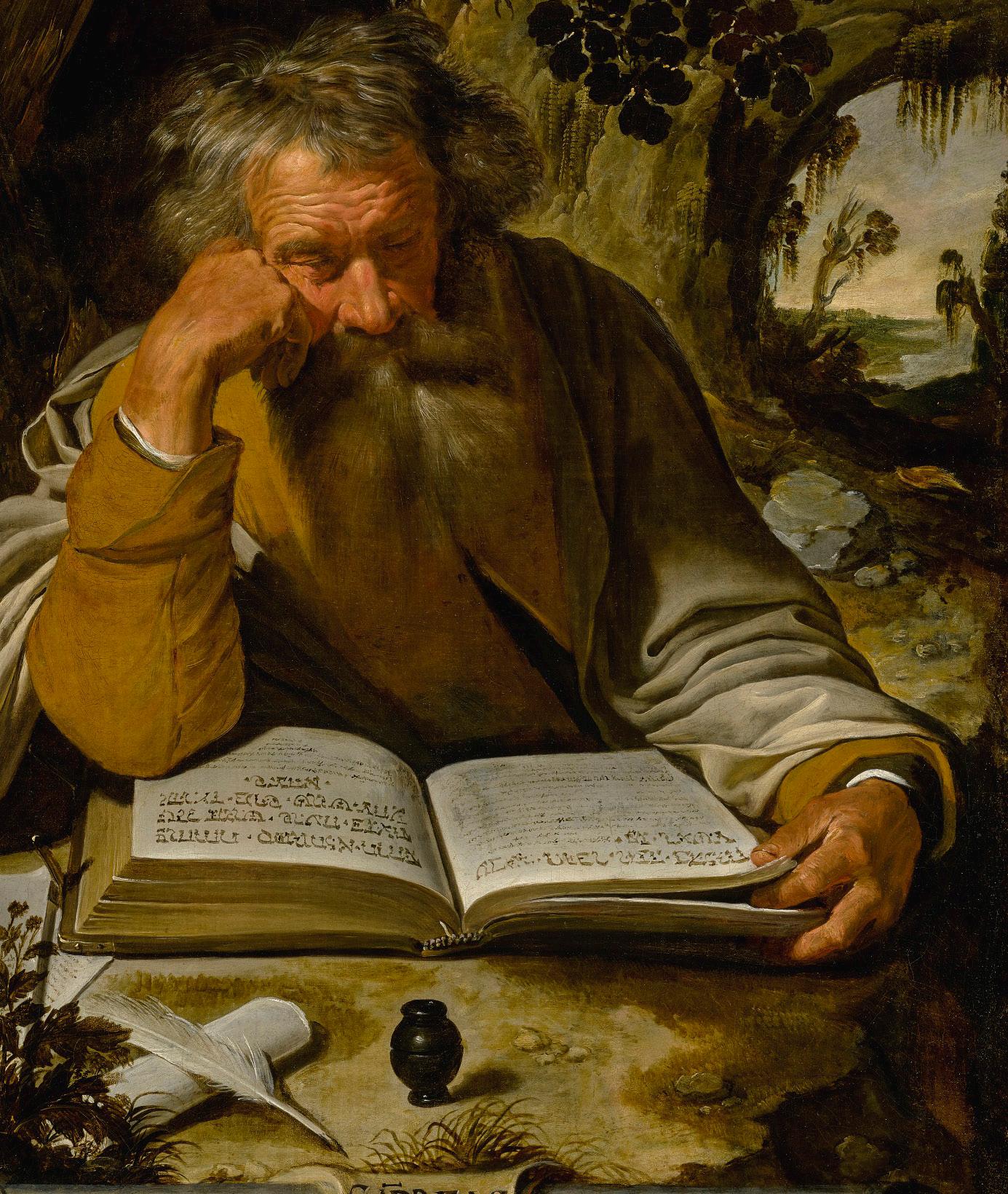
JACKSON – St. Andrew the Apostle is known as the “Protokletos,” or “The First Called’ to be an apos tle of Jesus.
In the Gospel of Matthew, Jesus was walking along the shore of the Sea of Galilee and saw Andrew and Simon Peter fishing. Jesus asked the two to become disciples and “fishers of men.” The Gospel of John states that Andrew was a disciple of John the Baptist, and when Jesus walked by one day, John the Baptist said, “Behold, the Lamb of God!” It is then that An drew, and another, made the decision to follow Jesus. In both stories, Saint Andrew answered the call to follow Jesus.
As members of the church, Jesus also calls us to be disciples to a new way of life, the Christian way of life, of which stewardship is a part. But Jesus does not call us as nameless people in a faceless crowd. He calls us individually, by name.
God intends each one of us to play a unique role
in carrying out the divine plan. The challenge is to understand our role, and to respond generously to this call from God.
Christian stewardship is recognizing that “Every thing we have and everything we are” is a gift from God and we are to be grateful and generous with those gifts.
The Spirit is calling and can show us the way. Stewardship is a part of that journey. Are you listen ing to the call?

St. Andrew was sentenced to a death of crucifix ion by the Romans in Greece. He asked to be cruci fied on a diagonal cross as he felt he wasn’t worthy to die on the same shape of cross as Jesus. His feast day is Nov. 30, the date of his death.
Excerpts: wordonfire.org; catholiccompany.com; catholicstewardship.com
Artwork: The Calling of Saint John and Saint Andrew, James Tissot, c. 1886-1894, Public Domain.
DIOCESE 7 MISSISSIPPI CATHOLIC NOVEMBER 23, 2022
‘Blessing is meant to be shared,’ Franciscan priest tells Black men
 By Mike krokos
By Mike krokos
INDIANAPOLIS (CNS) – It was a time of Scripture, prayer, music and fellowship.
It also was a night to honor the late co-founder of the National Black Catholic Men’s Conference.
But for those teenagers and adults from across the United States in atten dance, Franciscan Father Agustino Torres’ message Oct. 13 was simple, yet powerful: “The Lord has sent me to bless you.”
Father Agustino, who ministers for his order in the New York borough of the Bronx and is founder of the Hispan ic youth ministry Corazon Puro, was the keynote speaker on the first night of the four-day conference at St. Rita Church in Indianapolis.
The gathering drew about 300 people. It was the first in-person gathering since 2019 because of the COVID-19 pandemic.
Father Agustino shared how on his drive to the Newark Liberty Airport in New Jersey for his flight to Indianapolis earlier that day, his usual route led him into gridlock. Instead of fretting about the unforeseen challenge, the priest said he traveled a different way to the airport, trusting that God had a plan for him.
While on the unplanned route, Father Agustino took the time to roll down his window and bless the people he encoun tered.
“I blessed them all. I blessed them all,”
Father Agustino said. “When you share the Lord’s blessings, the Lord blesses you ten fold in return.”
The result? Father Agustino said that when he arrived at the airport, he was no tified his ticket was upgraded, which led to laughter and applause from the congre gation.
The priest said he ministers to people in the inner city, and the heart of his mission is trying to bring them hope. With that hope he also delivers his blessing, much like the blessing he offered to the attend ees.
“This blessing is meant to be shared, this blessing is meant to be given, this blessing brings joy,” he said. “This blessing brings life, this blessing heals. ... And I love sharing the blessing because someone has shared the blessing with me.”
Father Agustino reflected on a biblical verse from the prophet Jeremiah: “For I know well the plans I have in mind for you, says the Lord, plans for your welfare and not for woe, so as to give you a future of hope.” (Jer 29:11).
Despite the fact God has a plan for each of person, the priest continued, some have not shared his blessings. He encouraged people of faith to seek God’s gifts.
He encouraged the conference attendees to pray: “Lord forgive me for the times I knew not what to do with the blessing you gave me. Father, may I receive these blessings now.”
Like many of the prophets, each person is called to be faithful to God and trust in the Lord’s plans, the priest said.
“You are here because someone spoke life into your soul. You are here because someone woke you up when you were lost and brought you back to life when you were dead,” he said. “We give thanks to God for those
people. What would we be without those people?”
Father Agustino offered a blessing over the audience: “The Lord wants us to be anointed men to bring peace in our streets, in our homes, and in our hearts” to share God’s message of hope.
As he brings Jesus to the streets of his neighborhood, he, at times, must offer peace and prayers when he en counters evil, the priest said. “Sometimes, it takes cour age to stand up to evil, but the man who is blessed, the man who has been anointed, is equipped to face evil.”
Encountering a recent domestic dispute between a man and woman in his neighborhood, Father Agustino intervened despite the man’s insistence that he should not. “This is my business!” the priest said to the man with his voice raised. “This neighborhood belongs to God!”
When reflecting on his reaction, Father Agustino said, “Anger is the power given to us by God to confront evil. The Lord wants us to be angry to confront the evil that is there. ... My brothers, a man who is blessed, a man who is anointed, puts his anger” into his response to those situations.
As the man approached the priest, Father Agustino said, “I’m gonna pray for you!”
As we face life’s challenges, we must remember, a man who is blessed and anointed “does the right thing because it is the right thing,” Father Agustino added.
In living their vocation, a person at times will face evil within, he explained. But in failing, a person must remember “the Lord promises, we do have the strength, we do have the intelligence, we do have the fortitude, we
do have the commitment, and these are the truths that need to inform those lies that they no more have a place within us,” he said.
Receiving God’s blessing in an anointing, a person will be filled with joy, and “your life will never be the same,” Father Agustino continued.
“And you will not know for what you are living, un less you know that you are living for God.”
During the conference, organizers announced the event would be renamed in honor of its co-founder, Di vine Word Father Chester Smith. He died in April 2020.
The conference was launched in Indianapolis in 2004, with Father Smith playing an integral role in de veloping the yearly gathering, which helps carry out the mission of the city’s Bowman-Francis Ministry.
The ministry is named for two Society of the Divine Word priests and Sister Thea Bowman, a Franciscan Sis ter of Perpetual Adoration. Sister Bowman is a candidate for sainthood and has the title “Servant of God.”
The ministry’s mission is to “minister to the total Black Catholic: spiritually, physically and intellectually (and) ... to offer many gainful avenues to meet the needs of Black people everywhere,” according to its website.
Going forward, the event will be known as the Father Chester P. Smith, S.V.D., National Black Catholic Men’s Conference.
(Krokos is editor of The Criterion, newspaper of the Archdiocese of Indianapolis.)
DIOCESE 8 NOVEMBER 23, 2022 MISSISSIPPI CATHOLIC
Franciscan Father Agustino Torres, who ministers for his order in Brooklyn, N.Y., and is founder of the Hispanic youth ministry Corazon Puro, prays before delivering a keynote address at the National Black Catholic Men’s Conference at St. Rita Church in Indianapolis Oct. 13, 2022. (CNS photo/Mike Krokos, The Criterion)
NATION
BALTIMORE (CNS) – The U.S bishops were en couraged to send participants to the African National Eu charistic Congress, slated for July 21-23 in Washington, and to come themselves. Auxiliary Bishop Eusebio L. Eli zondo of Seattle, in a Nov. 16 address to the bishops, told them the congress, known as ANEC, would be “more en gaging” beyond the workshops that are part and parcel of the multiday gathering. He said there would be Masses, a eucharistic procession, a rosary procession and cultural celebrations on the congress schedule. “The ANEC is the right ground for the new evangelization, an opportunity for all of us to engage – dioceses, parishes, religious con gregations, associations and others – to address the pas toral needs of African Catholics in the United States,” he said. “Your presence will be a tremendous inspiration for those who will attend, and make the ANEC a success.” Next year’s African National Eucharistic Congress will be the fourth such gathering. It will be held on the grounds of The Catholic University of America in Washington. The congress is held every five years.
WASHINGTON (CNS) – Latinos may be changing American politics more than politics is changing Latinos. To hear speakers at a Nov. 16 Georgetown online fo rum, politics is trying harder to bring Latinos into the fold. Jens Manuel Krogstad of the Pew Research Center, in his work studying Latino demographics and politics, noted that Latinos do not identify as strongly with either the Democratic or Republican parties as do other Amer icans. “Latinos support for the two parties has ebbed and flowed over the decades,” Krogstad said during a fo rum sponsored by Georgetown University’s Initiative on Catholic Social Thought and Public Life on: “How Are Latinos Changing Politics and How Are Politics Changing Latinos?” Democratic support peaked at 70% during the presidencies of Bill Clinton and Barack Obama, while GOP support got as high as 40% for George W. Bush and 38% for Donald Trump. “Latinos are not a mono lith,” declared Olivia Perez-Cubas of the Winning for Women Action Fund, which recruits and gives financial backing to Republican women candidates. “The GOP de pends on its ability to build a tent to diversify the party – which we’re not very good at but I think we’re working on – to speak to a diverse group of voters, and Latinos are very much a big part of that equation.” The upshot of the Nov. 8 midterm elections for Latinos is that “ the community is consequential – it is very consequential –in which party will control Congress, in which party will prevail in presidential elections,” said Julián Castro, a for mer U.S. secretary of housing and urban development.
VATICAN
ASTI, Italy (CNS) – With several of his cousins and their children and grandchildren present, Pope Francis celebrated Mass in the Asti cathedral, giving a nod to his family roots and drawing people’s attention to the root of Christian faith: the cross of Jesus. The Mass Nov. 20, the feast of Christ the King and World Youth Day, was the only public event during the pope’s weekend visit to the region from which his grandparents, Giovanni An gelo Bergoglio and Rosa Vassallo, and his father Mario immigrated to Argentina in 1929. The visit was timed to coincide with the 90th birthday of Carla Rabezzana, the pope’s second cousin. And, after landing in Portacomaro near Asti Nov. 19 and stopping for a prayer in a village church, Pope Francis headed straight to Rabezzana’s house for lunch. After lunch, the pope visited a nearby home for the aged and then headed to the little village of Tigliole to visit another second cousin, Delia Gai. The cousins and their families joined an estimated 4,000 people for Mass with the pope the next day in the Asti cathedral. In his homily, sprinkled with words in the Pied mont dialect his grandmother taught him, Pope Francis focused on how the kingship of Christ is different from
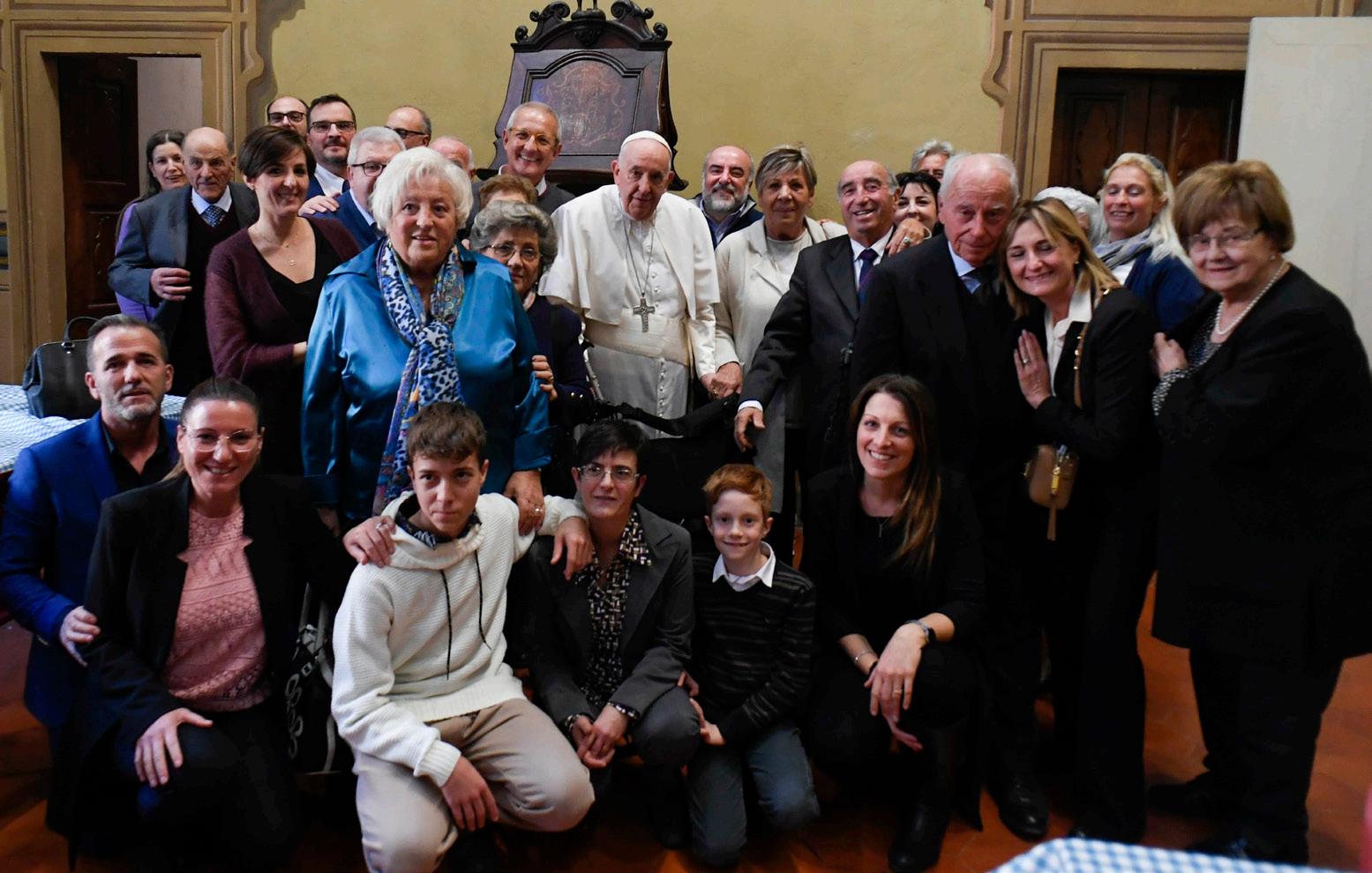
any idea people usual ly have of a king. “He is not comfortably en throned but hanging on a gibbet,” the pope said. “The God who ‘casts down the mighty from their thrones’ appears as a slave executed by those in power.”
VATICAN CITY (CNS) – The Vatican is willing to do whatever it takes to broker a ceasefire and bring an end to the war on Ukraine, Pope Francis said. “We are continually watching as the situation evolves” concerning ways the Vatican’s diplomatic ef forts could help, he said in an interview with the Italian newspaper La Stampa. Vatican News published the interview Nov. 18. The Vatican Secretariat of State is working diligently ev ery day, looking at every possibility and “giving weight to every opening that could lead to a real cease-fire and real negotiations,” he said. “The Holy See is willing to do everything possible to mediate and end the conflict in Ukraine. We are trying to develop a network of rela tionships that will foster a rapprochement between the parties, to find solutions. Also, the Holy See does what it must to help the prisoners,” he said, as well as pro vide humanitarian support “for the people of tormented Ukraine, whom I carry in my heart along with their suf fering.” Asked about the prospects for reconciliation be tween Russia and Ukraine, the pope said, “I have hope. Let’s not resign ourselves, peace is possible. But we must all strive to demilitarize hearts, starting with our own, and then defuse, disarm violence. We must all be paci fists,” he said.
VATICAN CITY (CNS) – The centuries’ old silver fir tree that had been destined to become the centerpiece Christmas decoration in St. Peter’s Square will now live, perhaps to see another century. Forest service rangers arrived at the scene – a mountain grove in central Italy’s Monte Castel Barone – Nov. 14 to alert workers to halt preparations for felling the tree. When it emerged back in 2019 that the small village of Rosello in Italy’s central Abruzzo region was donating the tree to the Vatican for 2022, local activists started flagging problems, such as the lack of transparency concerning the donation and the failure to carry out an environmental impact study. Dario Rapino, a lawyer and nature photographer, even wrote to Pope Francis in 2020, pointing to his encyclical “Laudato Si’ on Care for Our Common Home” and the importance of avoiding any unnecessary human impact on the environment, according to local media reports. Even the World Wildlife Fund had put out a statement Nov. 7 saying, “cutting a tree of this size in the midst of a climate crisis is a debatable decision,” which required “greater transparency.” However, it wasn’t until Rapino recently tracked down the 98-foot-tree, that he discov ered it was not located in Rosello, much less in the re gion of Abruzzo, but was, in fact, in a protected area in the nearby region of Molise in the township of Agnone, according to a report Nov. 12 by ChietiToday. The tree’s size, he said, also put it at around 200 years old.
WORLD
OXFORD, England (CNS) – European church lead ers have urged awareness of human rights issues during the FIFA World Cup in Qatar, amid continued criticism
that the Gulf state was allowed to host the tournament. “Women continue to be held back in Qatar, while non-Is lamic religions, including Christianity, are only granted limited freedom, and sexual minorities subjected to crim inal prosecution. All of this expresses, not just from a Western viewpoint, a repressive state and social order,” said Bishop Stefan Oster of Passau, who heads Germa ny’s Catholic DJK Sportjugend sports association. He said questions were still asked about the 2010 decision by FIFA, the international soccer governing body, to award the tournament to Qatar, which has no soccer tradition. The bishop issued the statement Nov. 17 as final prepa rations were made for the 2022 World Cup, Nov. 20Dec. 18. “Like other states on the Arabian peninsula, the Emirate of Qatar has been catapulted into a new era thanks to oil and gas wealth – today, a conservative-tra ditional Islamic society and economic hypermodern so ciety coexist with each other,” Bishop Oster said. “Al though it would be unfair to ignore this special situation when criticizing questionable conditions, it would also be inappropriate to keep silent about human rights restric tions.” The bishop said Qatar’s mostly foreign population was subject to “strict regulations,” while female domestic workers were often isolated and had trouble “upholding their rights against employers.” The situation had wors ened, Bishop Oster said, during construction of stadiums and other sites for the World Cup. He said health and safety standards had been “catastrophic,” with “countless accidents and far too many deaths” among low-wage la borers.
SÃO PAULO (CNS) – The Vatican has advanced the sainthood cause of the late Archbishop Hélder Câmara of Olinda and Recife, who may soon be called “venera ble.” Archbishop Fernando Saburido of Olinda and Reci fe made the announcement during the closing ceremony of the 18th National Eucharistic Congress. Archbishop Camara, one of the founders of the Brazilian bishops’ conference, was named to Olinda and Recife in 1964, three weeks before the beginning of the military coup that started the 20-year dictatorship in Brazil. Days after the coup, the archbishop released a manifesto supporting the Catholic workers’ action in Recife. The new military government accused him of being a demagogue and a communist, and he was forbidden to speak publicly. “If I give bread to the poor, everyone calls me a saint. If I show why the poor have no bread, they call me a com munist and a subversive,” the archbishop is said to have said during that time. Dom Hélder, as he was known, re mained a strong critic of the regime, denouncing human rights violations committed by police authorities.
BRIEFS 9 MISSISSIPPI CATHOLIC NOVEMBER 23, 2022
Pope Francis poses for a group photo with his cousins and their families after Mass and a luncheon in Asti, Italy, Nov. 20, 2022. (CNS photo/Vatican Media)
Gathering around the table for Thanksgiving


FROM THE ARCHIVES
By Mary WoodWard
JACKSON – Once again, we come to the great feast of Thanksgiving throughout our country. Looking back over the years I would like to share some moments at table in the presence of cherished friends, some of whom have gone on to the Lord where they will partake in the feast of Thanksgiving for all eternity.

When we gather around the table with friends and fam ily, we are sharing in communion with one another. I like to think all of our ancestors and dear ones, who made contri butions to our lives great and small, are gathered there with us forming a communion of saints.
And of course, the ultimate table for us to gather around is the altar where we share in the heavenly banquet with the entire communion of saints. The word Eucharist means thanks giving, so gathering around the altar for the celebration of the Eucharist is the most profound gathering of all gatherings.
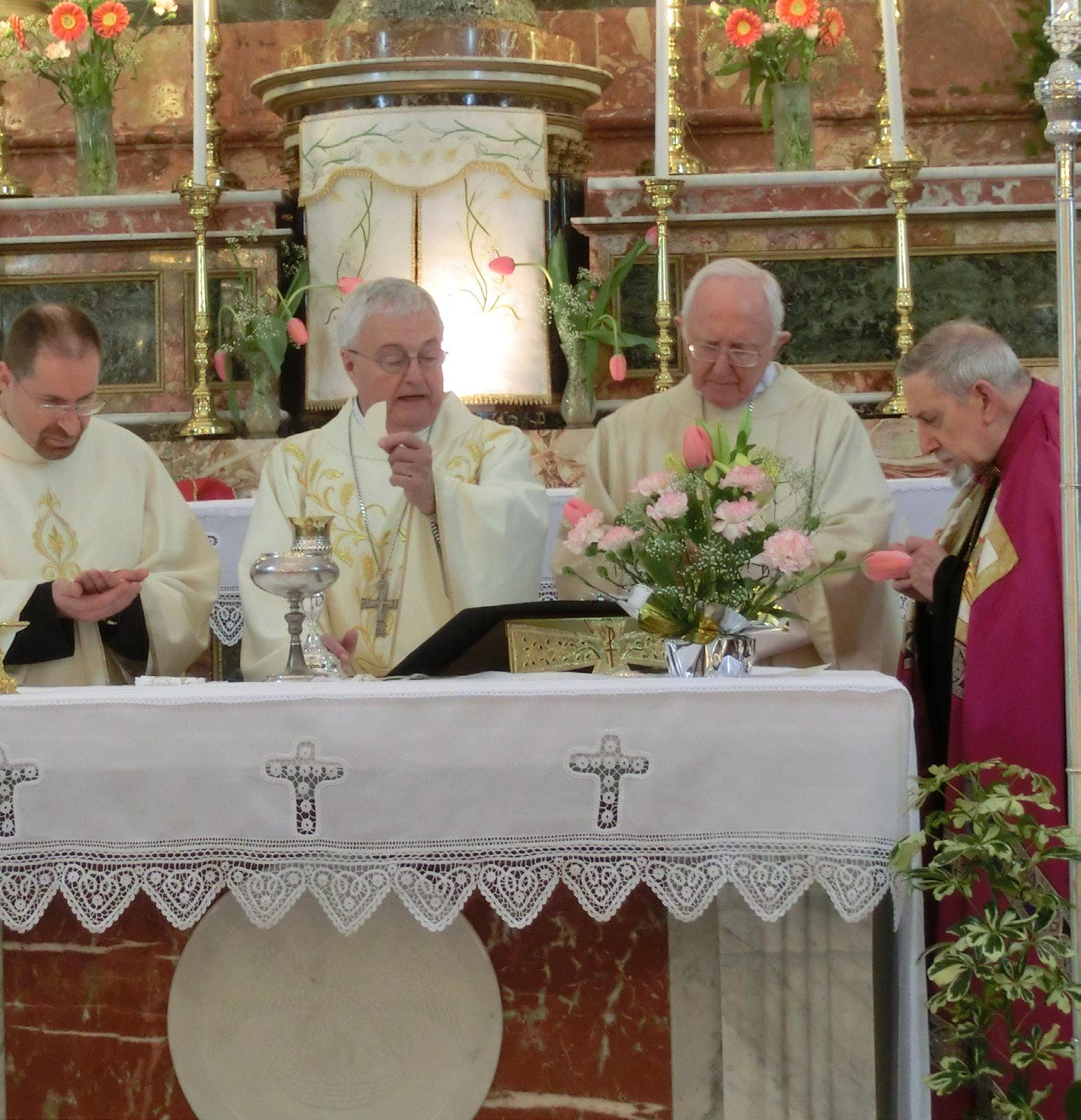
This Thanksgiving I hope we all are able to ponder the many blessings we have in our lives even if they are small. Take the time to let your friends and family know exactly how much they mean to you and what a blessing they are in your life.
Spend time in prayer for those who do not have family and friends available to them or are in strained family situations. Do not miss an opportunity to heal a rift and mend a heart by showing kindness, patience and love. You do not want to have regrets when that person is gone.
Most of all, give thanks to God for bestowing the grace, mercy and peace upon you that can only come from encountering and surrendering to God’s infinite heart. Take care of one another.
Pictured are gatherings around tables around the diocese over the years. The word Eucharist means “thanksgiving,” so gathering around the altar for the celebration of the Eucharist is the most profound gathering of all gatherings. (Photos courtesy of archives)
DIOCESE 10 NOVEMBER 23, 2022 MISSISSIPPI CATHOLIC
The Thanksgiving holiday offers a time for us to reflect on those ancestors and dear ones – to enjoy those present physi cally and those who are there transcending the moment in our memories. It is a time to be thankful for the moments we have shared and continue to share with those who love us and those whom we love.
(Mary Woodward is Chancellor and Archivist for the Diocese of Jackson.)
Two books look at Black Catholic experience from different angles
Because of a lack of acceptance by white religious communities, several Black religious orders were founded in the South, mainly to serve in Black schools and health care institutions, although many priests saw them as a “profanation of the habit.”

In at least one case, a Black religious community was not allowed to wear a hab it in their early years so as not to arouse any further community opposition than necessary. Some women of color who wished to enter religious life fled to Can ada or elsewhere to be able to live their vocations peacefully.
Even the Sisters of the Blessed Sacra ment, established by St. Katharine Drexel specifically to minister to Native Americans and Blacks, refused to admit African Amer ican or Native sisters into its novitiate for many years.
a helpful multiethnic view of the Catholic experience, although there may be too many in-jokes for those who may not have listened to them.
They describe their focus: “As Black women, we be lieve there is a place for everyone at the proverbial table, and that if there aren’t enough seats, we bring in another chair.
“This journey through the liturgical year is meant to create some additional space at that table for others to learn. In particular we are here to sit with our fellow Catholics of every background to help us all better un derstand our culture, our faith and our hope.”
“Fat Luther” explores several helpful topics of Black culture and history, such as appreciation vs. appropri ation, soul food, Black hair, the Black church, even code-switching and colorism.
These are the book covers of “Subversive Habits: Black Cath olic Nuns in the Long African American Freedom Struggle” by Shannen Dee Williams; and “Fat Luther, Slim Pickin’s: A Black Catholic Celebration of Faith, Tradition and Diversity” by Mar cia Lane-McGee and Shannon Wimp Schmidt. The books are reviewed by Kathleen Finley. (CNS photo/courtesy Duke Univer sity Press and Ave Maria Press)
 By Kathleen Finley (CnS)
By Kathleen Finley (CnS)
”Subversive Habits: Black Catholic Nuns in the Long African American Freedom Struggle” by Shannen Dee Wil liams. Duke University Press (Durham, North Carolina, 2022). 424 pp., $29.95.
“Fat Luther, Slim Pickin’s: A Black Catholic Celebra tion of Faith, Tradition and Diversity” by Marcia Lane-Mc Gee and Shannon Wimp Schmidt. Ave Maria Press (Notre Dame, Indiana, 2022). 192 pp., $17.95.
In Catholic books, an African American perspective is usually missing; these two books attempt to address that important gap in different and complementary ways.
In “Subversive Habits,” historian Williams has given us a remarkable work of scholarship, one that may be distressing for many readers because she clears away any shred of doubt about the U.S. Catholic Church being racist from its very beginnings.
That, unfortunately, includes the key roles that wom en religious have played in the building of the church.
Williams writes, “Few have considered what it meant that most of the sisters to minister in the United States before 1850, including the nation’s earliest female saints and sainthood candidates, were slaveholders or people who relied on the labor, sale and brutal mistreatment of enslaved people – and the economic benefits of white ness and racial segregation – to establish and secure the financial futures of their orders and celebrated social ser vice institutions.”
As she traces the hidden history of Black sisters, she admits that the only Black nun she had ever seen per sonally was Whoopi Goldberg’s fictional character in the movie “Sister Act.” That was true also of her mother, both of them lifelong African American Catholics.
Williams, a Catholic News Service columnist, tells story after story of institutional and personal barriers to pursuing religious vocations for African American wom en who, in many cases, were of mixed race because of their white fathers’ unions with Black women.
Most white religious communities refused to accept Black applicants, unless they could “pass” for white –and in several cases when women who were in positions of authority were later found to have been Black or of mixed race, they were largely erased from the commu nity’s archives.
By 1903, a Belgian priest ministering in Virginia complained to Rome about white religious communities. “In every convent of religious women, a girl having a little Negro blood in her veins is immediately rejected. It does not matter at all that she is well-ed ucated, pious, pure and truly Catholic, so long as she seems Negro or there is the slightest suspicion of color.”
Even in the post-World War II era, Black women still had to battle for any acceptance at all in religious life, although their struggle was helped somewhat by the per spectives of Vatican II and the civil rights movement.
In 1989, when Sister Thea Bowman, one of the best-known African American women religious and then dying of cancer, ad dressed the U.S. Conference of Cath olic Bishops she observed that most of those ministering in the Black com munity are not Black and “do not feel an obligation to learn or understand Black history or spirituality, or culture or life – Black tradition or ritual.”
As Williams clearly shows, in the face of nearly impossible odds, Black women religious have made impres sive contributions to the church they love. “In the long-standing absence of an empowered African American cler gy, Black sisters served as the most genuine and effective leaders of the African American community. ...
“As educational and moral lead ers, African American sisters instilled racial pride, molded community ser vants and, most important, taught that racism and sexism had no place in the church – long before the bishops and others collectively did so.”
The book “Fat Luther, Slim Pickin’s” shifts our focus from vowed religious to laywomen and a folksy look at ev eryday life in Black Catholic homes.
Authors Lane-McGee and Schmidt give the reader an informative glimpse into what celebrating the faith looks like for them, based loosely around the liturgical year, although the section on Ordinary Time seemed to be in an odd order.
The authors also have a podcast, “Plaid Skirts and Basic Black,” and give
Each season includes a companion, such as St. Martin de Porres, and a gentle sense of humor at times. “And here’s the thing: the Holy Spirit doesn’t care if your Ad vent wreath is made from four tiny birthday candles you found at the bottom of a drawer. The Spirit will come as long as you make room.”
Pull up a chair and make yourself at home.
(Also of interest: “Race and Rhyme: Rereading the New Testament” by Love Lazarus Sechrest. Wm. B. Eerdmans Publishing (Grand Rapids, Michigan, 2022). 414 pp., $39.99.)
(Finley is the author of several books on practical spiri tuality, including “The Liturgy of Motherhood: Moments of Grace” and “Savoring God: Praying With All Our Senses,” and formerly taught in the religious studies department at Gonzaga University.)
NaTION 11 MISSISSIPPI CATHOLIC NOVEMBER 23, 2022
Remaking ordinary time
ON ORDINARY TIMES
By Lucia a. SiLecchia
She was selling her wares at a rural autumn festival –the hand-knitted scarfs, sweaters, baby clothes and blan kets that she made to sell to those of us gathered around her table to admire her creations.
I had purchased a few things from her last year – for myself and for loved ones. So, I was glad to see that she was back. Patience is not a strong suit of mine. Hence, my admiration for those who take so much time to make something beautiful by hand is particularly great. This year, I bought a blanket knitted with some favorite colors in a joyful design.
There was a fortunate, brief lull in the activity around the table – interrupted only by a young woman who stopped by to buy a dinosaur hat that, somehow, she managed to wear with style. The chill in the air, perhaps, prompted this otherwise unlikely fashion choice.
In that interlude, I asked how long it took to make a scarf, or a baby blanket, or, yes – a dinosaur hat. The friendly artisan gave me her best estimates. But then she
told me that it could take much longer be cause sometimes she found herself in the midst of a project, would look at it honestly, decide it was not right, unravel it and begin again.
I suppose it should not have surprised me that some one who created such beautiful things would have a bit of the perfectionist in her. Yet, it also struck me that it must be difficult to look at something that had taken so much time and effort to make and be willing to unravel it all and start anew.
I wonder, though, if there is great wisdom in having the strength to do just that. To make a change and to unravel errors, misplaced values and mistaken priorities takes grace and strength. To start afresh without cling ing to the false starts of the past is a gloriously difficult challenge.
Perhaps, as the days shorten and another year is winding down, the knitter’s wisdom may have a place. When we start to look back at the year that is drawing to a close and prepare for the excitement of a new year with its fresh starts and resolutions, it is easy to tinker around the edges of things and make some small adjust ments to the patterns of everyday life.
Yet, sometimes in life, there can be an invitation to do more and to make more radical new beginnings.
I suppose that I would never have noticed if the blan ket I bought had defects in it. “Pretty good” would have been good enough for me. Yet, it would not have been good enough for the talented woman who knitted it to gether. She knew that sometimes starting over was the best way to move beyond “pretty good.”
Maybe in this season of joyful hope and new plans, a prayer for the grace to unravel the old and begin again is a prayer worth praying.
A blanket, hat or sweater created from the unraveling of imperfect ones are beautiful things. Yet, we have also been promised that “whoever is in Christ is a new cre ation.” 2 Cor. 5:17. I have to think that a newly created son or daughter of God is far more beautiful.
So, with gratitude for the good example of a knitter willing to unravel the old and reweave the new, I hope she is an inspiration to do the same and remake our or dinary times.
(Lucia A. Silecchia is a Professor of Law and Associate Dean for Facul ty Research at the Catholic University of America. “On Ordinary Times” is a biweekly column reflecting on the ways to find the sacred in the simple. Email her at silecchia@cua.edu.)

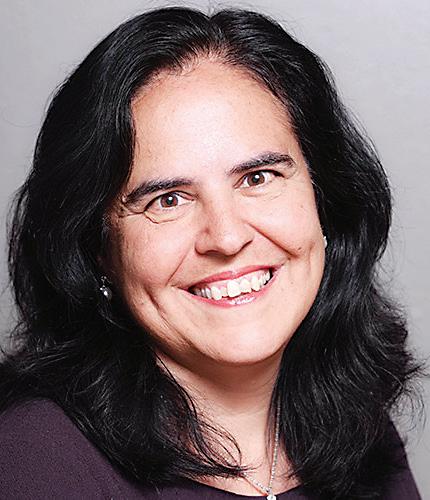
FOR THE JOURNEY
By effie caLdaroLa (cNS)
My great-grandfather, a refugee from the devastating famine in Ireland, came to Nebraska to farm. Generations later, I grew up on that farm.
I have roots – literal and figurative – in the land he purchased, a very small acreage of which I still own.
These roots help me to identify with the farming images of the Gospel. Jesus lived in a largely agrarian economy.
Sowing, reaping, noticing weeds along the roadside – this was Jesus’s world. He saw sheep grazing on hillsides, fishing boats plying the waters, full measures of grain being pressed into laps.
He knew the familiar smells of manure, and the fishy odor of a catch being unload ed. Jesus lived in an earthy, messy, tactile world.
So, the other day when the Gospel reading was about the man who was harvesting so much grain that he decided to tear down his barns and build bigger ones, I could identify.
I’m familiar with the language of grain prices, yields (how many bushels did an acre produce), the perennial worries about hail and drought.
And I certainly know people who have built bigger barns. We might call that suc cess or business acumen, and sometimes it is.
But in the reading from Luke 12, Jesus couches his story about the rich man who built bigger barns as a story of greed. Why?
First of all, notice how often Jesus rails against hypocrisy and greed. These are the social sins he cares deeply about.
Jesus lived among the poor, in a society that offered no “safety net.” The rich grew richer without fair taxation, a story familiar in America today.
So what’s the problem with the successful farmer? I don’t think his ample harvest is what Jesus decries. No, instead it’s his attitude toward wealth and his inability to see the bigger picture of his own life.
In Jesus’ parable, the rich farmer dies and is called to account for his life that very night, after his big barns are built and he’s feeling flush. What good is his wealth to him now? All of us will face that day.
Jesus says, “Thus will it be for the one who stores up treasure for himself but is not rich in what matters to God.”
He adds, “Take care to guard against all greed, ... for one’s life does not consist of possessions.”
Stuff. We Americans have an enormous amount of stuff, and yet we always want more. We rent millions of storage units for our possessions, and yet we want more.
It’s a spiritual challenge, especially with the excess and con sumerism of an American Christmas approaching.
It’s normal to save and plan for retirement. And yet, how often do we obsess about it?
Like the greedy farmer, we yearn to eat, drink and be merry – when we have “enough.” But what is “enough”?
Our church proclaims a “preferential option for the poor.” This term was first used by Father Pedro Arrupe, leader of the Jesuits, in 1968. St. John Paul II wrote of an “option for the poor” in his 1991 social encyclical “Centesimus Annus.” This concept runs throughout Hebrew and Christian Scripture.
Does it run through our lives? Do we vote with this concept in mind? Do we give, not just from our excess, but sacrificially, to the Lord through his poor, first? Do we feed the hungry? Welcome the refugee, like my great-grandfather? Clothe the naked?
When Jesus tells us to “take care,” I think he wants us to understand how short life is and how much better our lives and world could be if we lived simpler, more gener ous lives in every way.
(Effie Caldarola writes for the Catholic News Service.)
The Diocese of Jackson has launched a third-party reporting system that will enable all diocesan employees, volunteers and parishioners to anonymously (or named if preferred) make reports. Examples of this activity include fraud, misconduct, safety violations, harassment or substance abuse occurring at a Catholic parish, Catholic school or at the diocesan level. The system is operated by Lighthouse Services. Based in Deerfield, Illinois, Lighthouse Services maintains ethics, safe ty and fraud hotlines for over 4,100 organizations between the U.S. and abroad.
To make a report visit www.lighthouse-services.com/jacksondiocese or call 888-830-0004 (English) or 800-216-1288 (Spanish).
The Association of Priests of the Dioceses of Jackson and Biloxi provide a small pension to our retired priests. As you consider your estate plans, please remember these faithful servants by making a do nation or leaving a bequest to the Association of Priests. Our parish priests dedicate their lives to caring for us, their flocks. Let us now care for them in their retirement. Donations can be made payable to the Association of Priests and can be mailed to: Diocese of Jackson, Attn: Cathy Pendleton, P.O. Box 2248, Jackson, MS 39225-2248
12 Columns
NOVEMBER 23, 2022 MISSISSIPPI CATHOLIC
‘Take care to guard against all greed’
NCEA reports quicker academic recovery from pandemic for Catholic schools
By Mark Pattison
WASHINGTON (CNS) – The National Catholic Educational Association says Catholic schools have recovered more quickly from the pandemic than its public school counterparts.
The successes, according to the NCEA, go across the board when looking separately at Black students, Hispanic students, students from low-income house holds, and students who qualify for free and reduced-price meals.
The scores were first reported in October by the National Assessment of Ed ucational Progress, colloquially known as “The Nation’s Report Card.” The num bers tracked the progress, or lack thereof, in math and reading by both fourth graders and eighth graders.

While Catholic schools’ scores are generally better than those of their public school counterparts – Annie Smith, NCEA vice president of data and research, said eighth graders pre-COVID-19 were about 5% better in math and 6% better in reading – the new numbers, based on testing conducted in 2021, showed a wider separation between the two.
Catholic schools’ scores have pretty much bounced back to the levels they had achieved prior to the coronavirus pandemic’s onset in March 2020. The only area that is still not up to snuff is eighth-grade math, which is still five points behind pre-pandemic levels.
Even so, said NCEA president Lincoln Snyder, those numbers are 15 points ahead of the comparable figures reported by public schools.
“It wasn’t a surprise to me at all,” Snyder told Catholic News Service in an Oct. 28 phone interview. “We’ve been monitoring testing data, really, throughout COVID.”
The NAEP numbers, Snyder said, bear out what a private firm found in 2021 when it conducted a lateral study of 3 million U.S. students to assess learning loss.
Given the upheaval wrought by the pandemic within society in general, and edu cation in particular, Snyder said, “you would expect all students to have some learning loss.” But it was the ability to bounce back that characterized much of Catholic educa tion, he added.
“It’s a testament to our educators to meet in person as soon as possible,” Snyder
said. “It greatly did improve our Catholic school outcomes.”
The NAEP numbers dovetail with the NCEA’s own census showing that, for the first time in 20 years, enrollment in Catholic schools across the United States increased by 62,000. The number of Catholic schools also stayed steady, as 50 new schools were created to offset the closing of 50 other schools.
“We did have a big uptick in enrollment. We had an initial drop. In March of ‘20, when we went to distance learning, people were fearful for losing their jobs. Or they did lose their jobs, but they quickly recov ered. “
Thanksgiving food drive
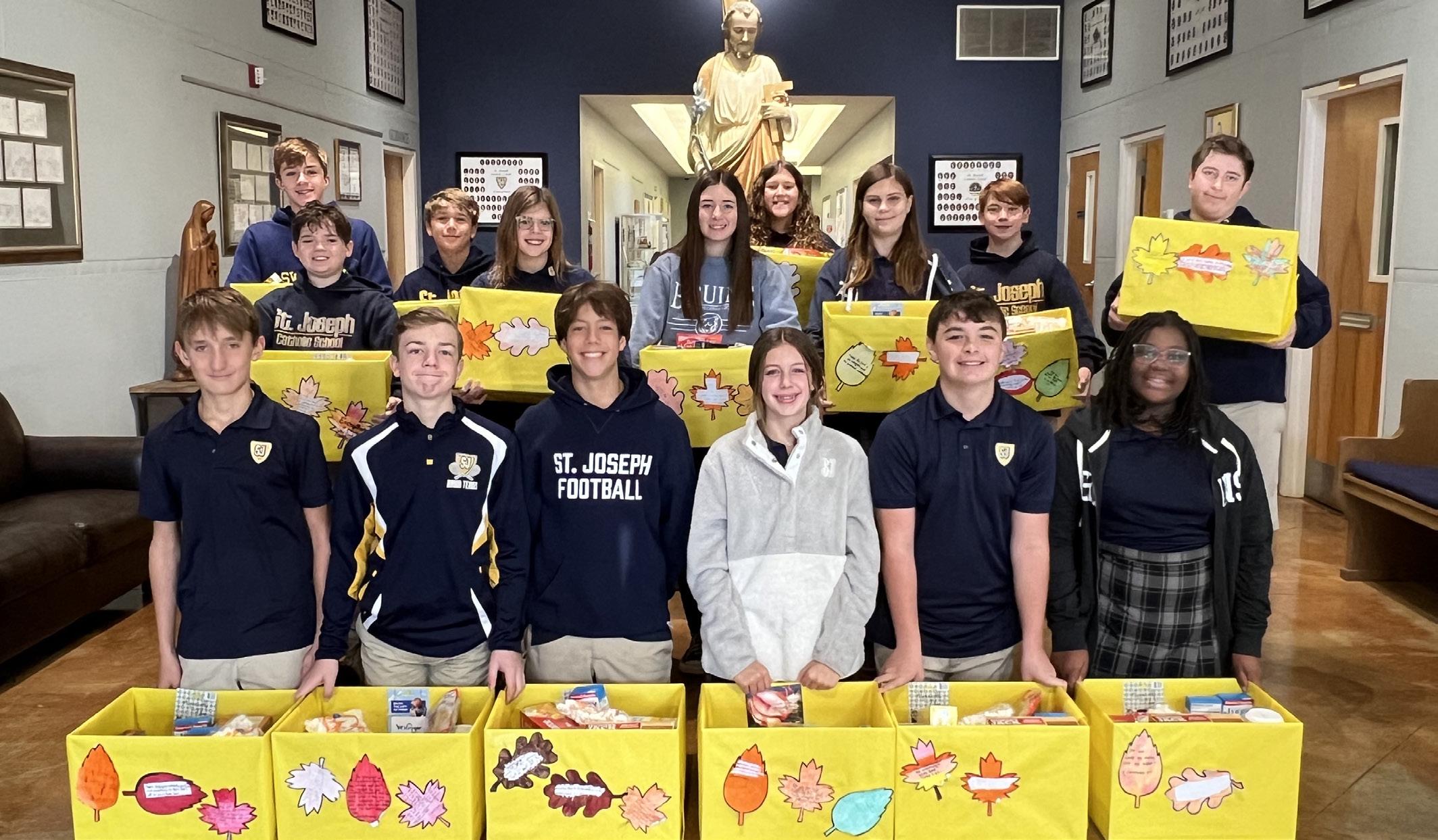
“Our retention of those new families was very high,” Snyder told CNS, citing a rate of 90% percent and “some dioceses were real ly as high as 98%.”
“They fell in love with the school, but they also stayed because of the community. This is a real opportunity for us to shine,” he said.
Only about one-third of dioceses had re ported enrollment numbers for the current school year to the NCEA. A final tally is not expected until the spring.
Smith told CNS in a Nov. 1 phone inter view that for Catholic schools to get back to their 2019 achievement levels, “our teach ers are doing what they need to do already. They’re in the classroom, they’re working with students, they’re creating individualized learning plans.”
She confessed to being “a little disap pointed with the drop in the eighth-grade math” scores, but “they’re going to graduate into our high schools, so we’re going to make sure this doesn’t have a long-term impact.”
Snyder said the NCEA has to “do a good job of telling our story.”
“I think we have a very compelling story to tell,” he explained. “We educate the whole children. We teach them to be servant lead ers in Christ. Our teachers really model that servant leadership. I think they were com mitted to an adult that was committed to them. They can see that commitment and they responded to it.”
NATIONAL 13 MISSISSIPPI CATHOLIC NOVEMBER 23, 2022
MADISON – Seventh and eighth grade students at St. Joseph Catholic School in Madison successfully com pleted a Thanksgiving food drive, filling boxes with enough items to feed 15 families who otherwise may have gone without a family meal for the holiday. On the front row from left are William Kraft, Camp Hlavac, David Steckler, Harper Schuhmann, Noah Ingram and Synia Means. On the second row are Colt Alexander, Landry Erwin, Lily Cate Lumaghini, Maddie Morris and Josh Brown. In the back are Matthew Schenk, Samuel Klar, Susie Steckler and Jaden Taylor. (Photo courtesy of Terry Cassreino)
COLUMBUS – Eighth graders, James Cancellare and Tristan Fulton, work on math problems together in October 2022. (Photo by Logan Waggoner)
Activities around the diocese


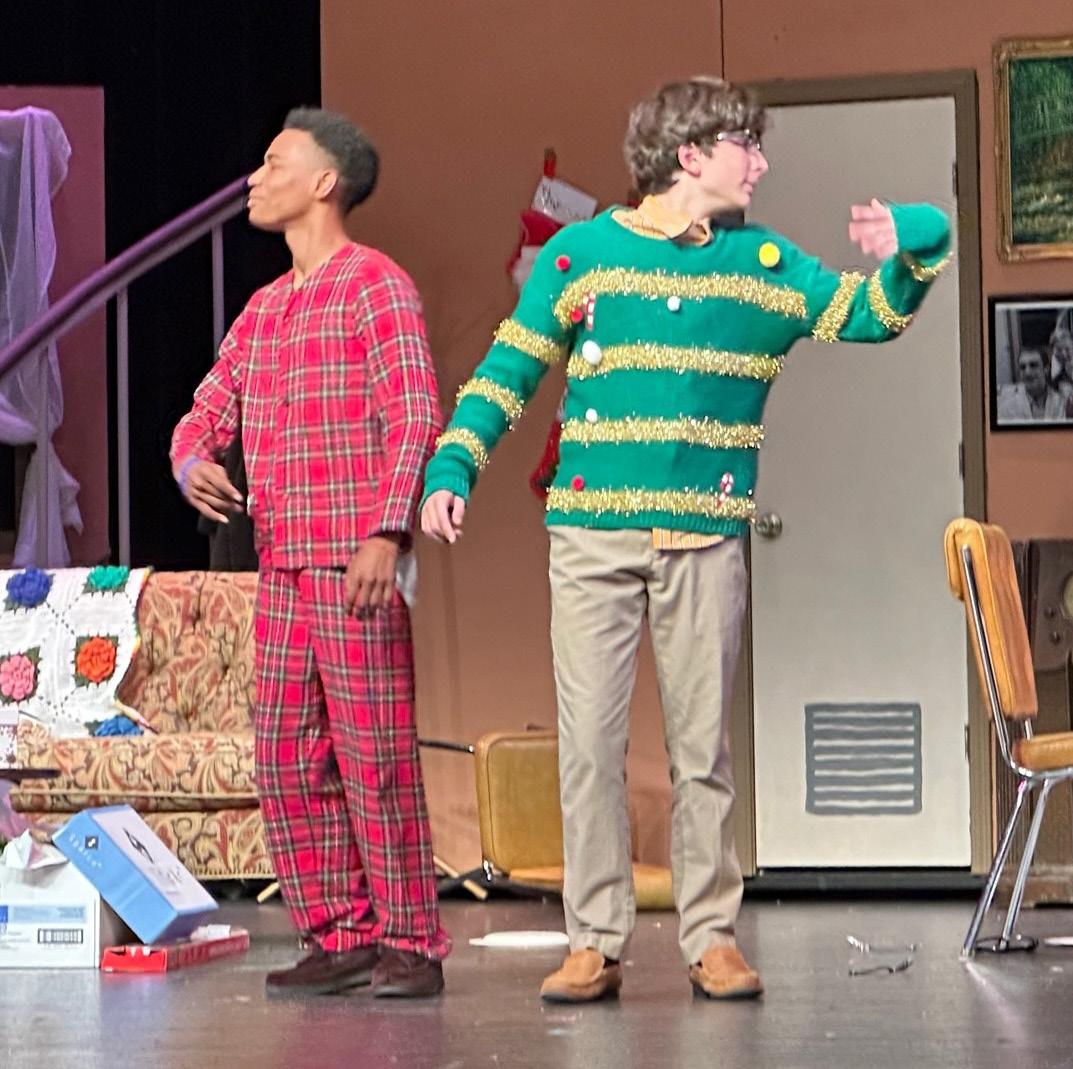
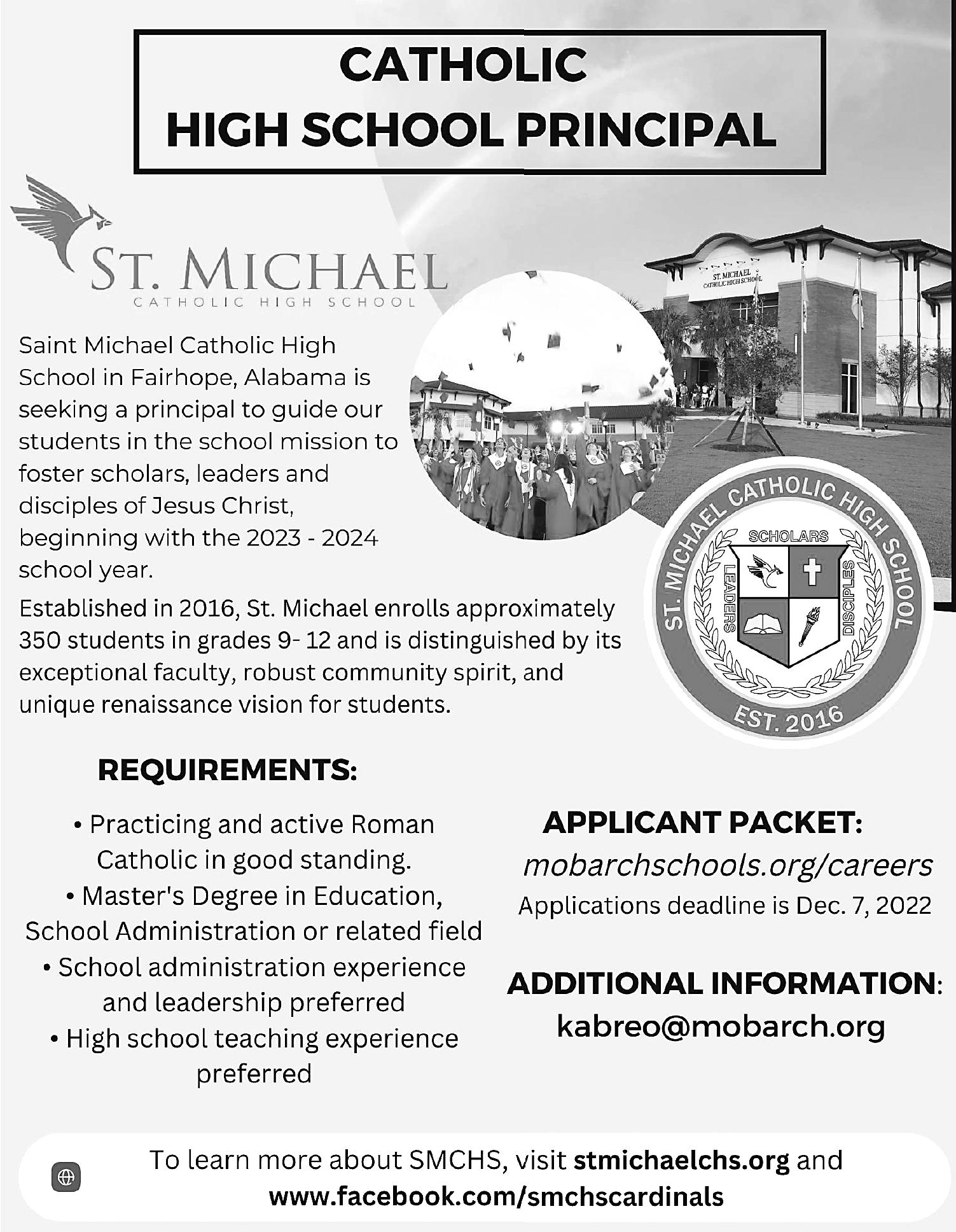

YOUTH 14 NOVEMBER 23, 2022 MISSISSIPPI CATHOLIC
HERNANDO – On Sunday, Nov. 13, the youth of Holy Spirit Church honored Veteran’s with a reception, cards and a jar of red, white and blue M&M’s.
(Photo by Amanda Ready)
MADISON – St. Joseph students (l-r) Jarret Hall (Ralphie) and Turner Brown (Ralph Parker) at the production of “A Christmas Story” on Saturday, Nov. 12. (Photo by Tereza Ma)
Thank you Veterans!
JACKSON - The mascot and cheerleaders for St. Joe Greenville celebrate after a big play at the MAIS 4A state championship game on Thursday, Nov. 17. (Photo by Joanna Puddister King)
JACKSON – On Thursday, Nov. 17, Sister Thea Bowman students faced off against St. Richard sixth grade girls on the court. (Photo by Tereza Ma)
Youth life around the diocese




MISSISSIPPI CATHOLIC NOVEMBER 23, 2022 15 YOUTH
COLUMBUS – Annunciation fourth graders used their Jeans for Green fund raiser money to shop for, pack, deliver and pray over 16 Operation Christmas Child boxes. (Photo by Logan Waggoner)
COLUMBUS – The Anunnciation "Robotics Team" competed in their first tournament on Saturday, Nov. 12. (Photo by Logan Waggoner)
VICKSBURG – Coach Larry Calhoun, the star of the Move To Learn exercise break videos came to Vicksburg Catholic School to introduce administrators, teachers and students to the Move to Learn Initiative! The videos feature Calhoun leading students in simple movement exercises that can be done in a small space. Teachers are noticing that incorporating the fitness breaks in the classroom has increased their students’ ability to learn and to focus on schoolwork. (Photo by Lindsey Bradley)
Annual National Prayer Vigil for Life will take place in Washington Jan. 19-20
WASHINGTON (CNS) – The National Prayer Vigil for Life held each January will continue even with the Supreme Court's reversal of Roe v. Wade because there is "still a great need for prayer and advocacy"' to end abortion and protect the unborn and their mothers, the U.S. Conference of Catholic Bishops said Nov. 11.
The vigil is hosted in Washington by the USC CB Secretariat of Pro-life Activities, the Basilica of the National Shrine of the Immaculate Conception and The Catholic University of America's Office of Campus Ministry.
Scheduled for Jan. 19-20 at the national shrine, the vigil has always coincided with the eve of the March for Life, which marks the date of 1973 deci sion of the court's Roe v. Wade ruling that legalized abortion nationwide. The 2023 March for Life is Jan. 20.
"The National Prayer Vigil is a time to praise God for the great gift of the recent Supreme Court Dobbs decision, overturning the tragic Roe v. Wade decision made almost a half-century ago," said Kat Talalas, assistant director of pro-life communica tions at the USCCB.
"State and federal legislators are now free to embrace policies that protect preborn children and their mothers," she said in a statement. "Yet, there is still a great need for prayer and advocacy from the faithful, as there will be intensified efforts to codify Roe in legislation and policies at the state and federal levels."
She added that "many prayers and sacrifices
are needed to transform our culture so that all may cherish the gift of human life and offer life-giving support to vulnerable women, children, and fami lies."
The opening Mass for the vigil will take place at 5 p.m. (EST) Jan. 19 with Archbishop William E. Lori of Baltimore, chairman of the USCCB's Committee on Pro-Life Activities, as the principal celebrant and homilist.
The Mass will be immediately followed by a Holy Hour for life. This will start off a series of nationwide holy hours throughout the night from dioceses across the country, which will be broad cast on the USCCB's website, www.usccb.org.
The nationwide vigil concludes at 8 a.m. (EST) Jan. 20 with a closing Mass to be celebrated by Auxiliary Bishop Joseph L. Coffey of the U.S. Arch diocese for the Military Services.
A live television broadcast of the vigil will be provided by the Eternal Word Television Network and will be available via livestream on the national shrine's website, https://www.nationalshrine.org/ mass.
The USCCB pro-life secretariat also is encour aging Catholics across the country to observe a nationwide prayer vigil from Jan. 14 to Jan. 20 to pray for an end to abortion and "a greater respect for all human life."

(Editor's Note: More details on the National Prayer Vig il for Life in Washington can be found at https://www.usccb. org/prolife/annual-pro-life-events.)

Mississippi Catholic is now printing one issue per month February through November and two issues in December and January. A second digital only edition will publish February through November. Catholics across the diocese can sign up to receive a digital copy of the paper on Flocknote by texting MSCATHOLIC to 84576 or by signing up at jack sondiocese.flocknote.com.

NOVEMBER 23 , 2022 MISSISSIPPI CATHOLIC 16 nation
Mississippi Catholic join our email list: text: MSCATHOLIC to 84576
A person prays with a rosary during the opening Mass of the National Prayer Vigil for Life Jan. 20, 2022, at the Basilica of the National Shrine of the Immaculate Conception in Washington. (CNS photo/Bob Roller)






















 By Mike krokos
By Mike krokos






 By Kathleen Finley (CnS)
By Kathleen Finley (CnS)















